oceans
A Healthy Coral Reef Is a Symphony
This story is part two of a two-part series. Read part one here.
You might have heard that the Great Barrier Reef is the world’s largest collection of coral reefs, a natural wonder stretching over 1,400 miles off Australia’s Queensland coast, hosting 400 types of coral and thousands of fish species. Since 1981, it has been recognized as a UNESCO World Heritage Site, and most of its ecosystem is protected.
But you might not know that it is also the stage for daily underwater concerts. Take a dive or listen to marine biologist Steven Simpson’s recordings and you hear grunt fish grunt, shrimps snap, damselfish chirp, clownfish grumble, sperm whales click and humpback whales sing their soprano mating songs that are audible over tens of miles.
“When I tell them fish have ears, people look at me like I’m mad,” says University of Bristol professor Steve Simpson. He and his colleagues were initially ridiculed by their peers when they started eavesdropping on fish communication nearly 20 years ago, but their sound experiments have been recreated successfully so many times that they are established science now. Recent research has revealed that dolphins call each other by name, turtle embryos coordinate their birth with one another from inside their eggs, and a coral reef is also a symphony that attracts coral larvae. Much like doctors use stethoscopes to assess the healthy heartbeat of a patient, the interdisciplinary science of ecoacoustics, which investigates natural sounds and their relationship with the environment, has emerged as an effective solution not only for monitoring the health of marine ecosystems, but also for restoring them.
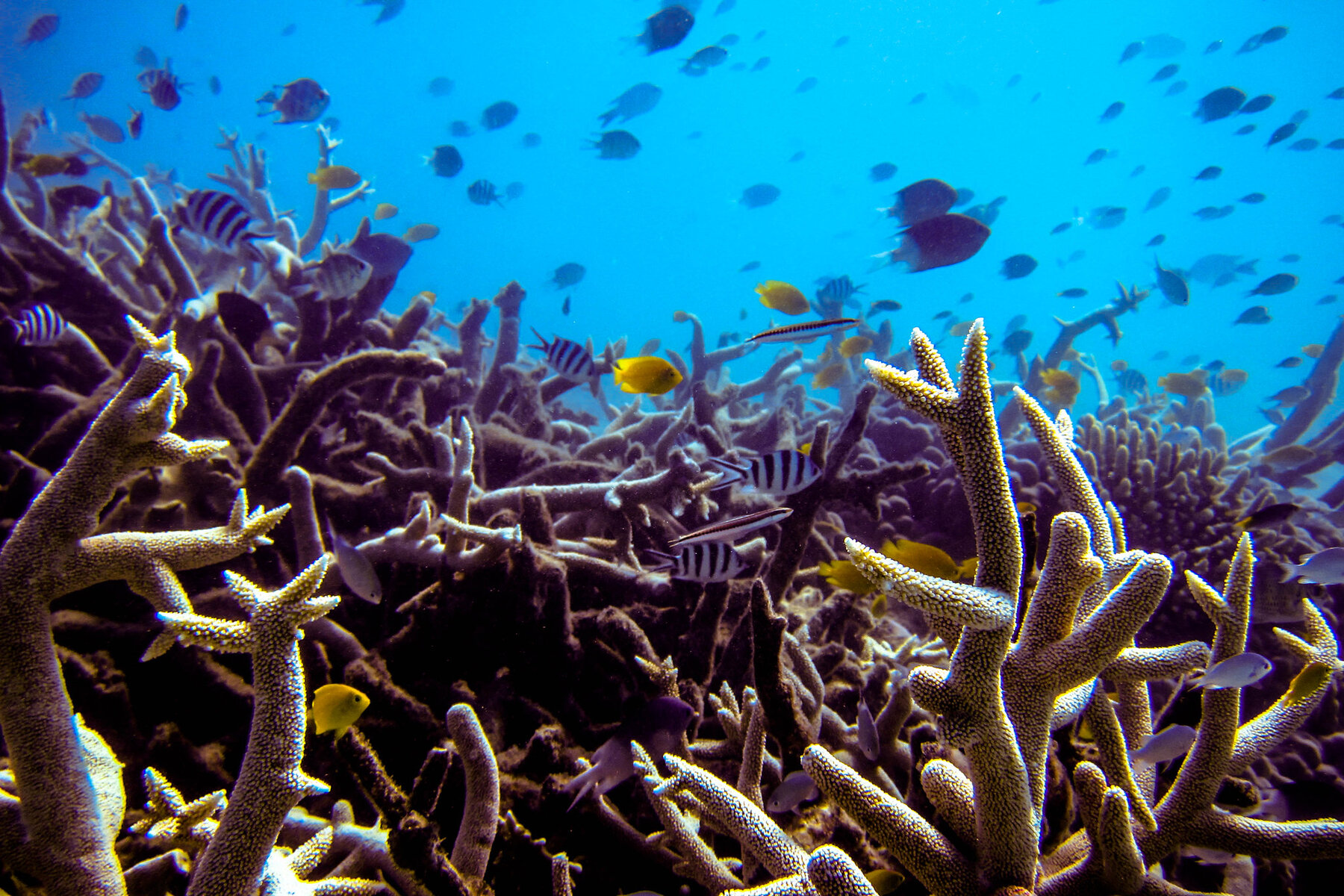 Fish and crustaceans use all their senses to find suitable habitat. Credit: Ryan McMinds Flickr
Fish and crustaceans use all their senses to find suitable habitat. Credit: Ryan McMinds Flickr
The world has lost half its coral reefs in the last 30 years, and researchers are racing against the clock to support these invaluable habitats in their battle against warming waters, pollution, overfishing and acidity. “Scientists predict that, if we continue along the current global warming trajectory, coral reefs will entirely disappear from the oceans within 30 years, threatening the livelihoods of the more than one billion people who depend on them for food, medicine, and coastal protection,“ the late University of British Columbia professor Karen Bakker writes in her fascinating book The Sounds of Life. “The disappearance of corals is a death knell for many other species.”
As the coral reefs disappear, so too does their chorus. “When a reef diminishes, the diversity and complexity of the sound goes missing, too,” Simpson says. “It becomes an acoustic desert. You can really hear the difference between an overfished reef and a marine protected area. You can hear the biodiversity.”
Reasons to Be Cheerful · Coral Reefs
When Steven Simpson attended the UN climate conference COP27 in Sharm el-Sheikh in 2022, he and his team wanted to demonstrate to the attendees the difference in biodiversity between protected and unprotected marine areas. By coincidence, they happened upon a sound technician who had all the necessary gear because he had just live-streamed a Red Hot Chili Peppers concert from the Egyptian pyramids. “We dropped a hydrophone out on a buoy and beamed the sound back to the conference, where the director general of the United Nations and all the politicians and experts were able to listen to the life-streaming of coral reef sounds,” Simpson says. “It was an immersive, emotional experience. Sound moves us on a dance floor, in a movie, and to be listening to a live coral reef is something very powerful.”
It moves fish, too. Fish and crustaceans use all their senses to find suitable habitat, including audio. And just like a good soundtrack might attract humans to a movie or concert, the sounds of a vibrant reef attract fish and coral. When Simpson played the recording of healthy reef sounds over compromised reefs in Australia, he found that double as many fish settled into these reefs. Simpson compares his underwater DJ job “to a real estate agent who sings the praises of a new housing development long before it’s an exciting place to live.”
Credit: Steve Simpson
When a reef diminishes, Steve Simpson explains, it “becomes an acoustic desert,” as the reef pictured here did after bleaching.
For a study recently published in the Royal Society Open Science journal, researchers set up an underwater speaker broadcasting the bustling sounds of a thriving reef on a degraded reef off the US Virgin Islands in the Caribbean. The experiment confirmed that the underwater concert attracts up to seven times more coral larvae and fish than a decimated reef without acoustic enrichment.
Coral larvae are often microscopically small and float in the ocean before they settle permanently on a reef. They don’t have brains or ears, but studies have discovered they are sound-sensitive, probably through their tiny hairs (epidermal cilia) that detect vibrations.
Crushed by negative news?
Sign up for the Reasons to be Cheerful newsletter.
[contact-form-7]
Seventy years ago, legendary oceanographer Jacques Cousteau described the underwater world as “the silent world,” but we now know that is far from the truth. Not only is there sound down there, but that sound is complex, rich and varied over time. Simpson distinguishes between “the morning chorus when the daytime fish emerge and the dusk chorus when the nocturnal fish come out; you hear an increase in the breeding season and during the new moon when it’s darker. There is a temporal structure to the soundscape.”
Technology has accelerated both the number of recordings and the speed of their evaluation. Steve Simpson remembers “building a Walkman in a barrel with a synchronized swimming pool speaker that we hung over the reef with the car battery in the 1990s. We pretty much managed to miss all the output of the fish that year.” But technology improved after 2000. That’s when Simpson, his graduate student Tim Gordon and other pioneering marine biologists like Robert McCauley, a professor at Curtin University in Perth, Australia, found that fish, clams, lobsters, even corals and their microscopically small larvae all use sound to find their way to healthy habitat.
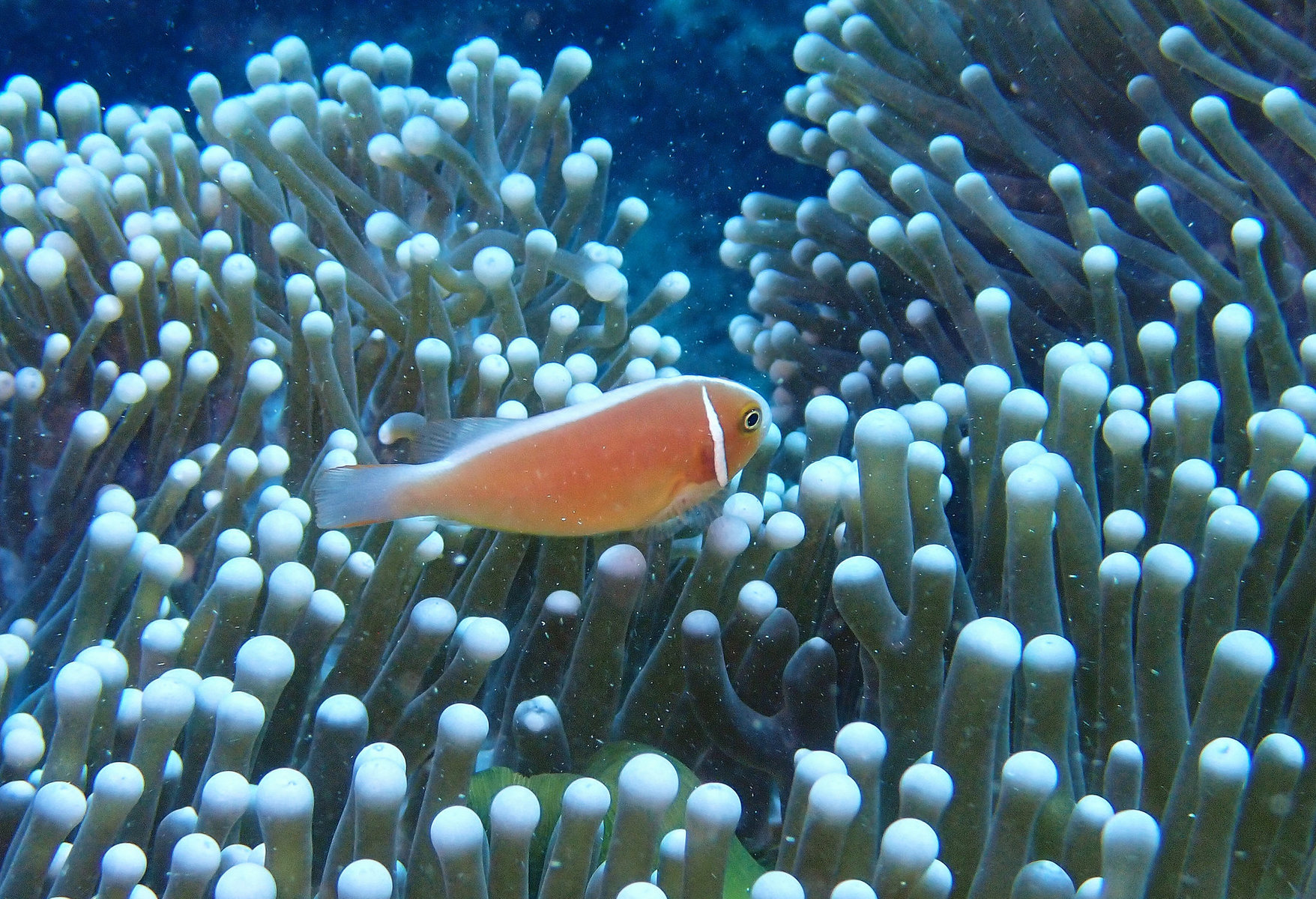 A pink anemonefish swimming in the Great Barrier Reef. Credit: Donald Davesne / Flickr
A pink anemonefish swimming in the Great Barrier Reef. Credit: Donald Davesne / Flickr
“Animals are using a hierarchy of senses as they try to resolve complex challenges in their environment,” Simpson explains. “We realize that the fish at sea are doing much what we would do if we were moving to a new city: we’d perhaps get on the internet and do some research into different suburbs that we might want to live in. Fish might use sounds to find the coast or a healthy reef, then the smell of mangroves or seagrasses, and then once they get close, they use vision.”
Simpson compares it to trying to find a friend that you lost in a crowded music festival. “You might wander around the crowd for hours. But if you know they wear a yellow t-shirt and you lost them at the hot dog stand next to the jazz stage, you can listen for the jazz, then smell the hot dogs and then look for the yellow t-shirt. Except for fish, it’s life or death whether they make the right decision where to settle.” Fish, Simpson quips, are “much smarter than people at festivals.”
In the years 2015 and 2016, Simpson’s team was working in the pristine marine protected areas of the Northern Great Barrier Reef when a catastrophe hit. A heat wave bleached out the reefs so fast Netflix made a blockbuster documentary film about it, Chasing Coral.
“We watched the reef die in front of us,” Simpson remembers. “That was a real wake-up call that no matter how much effort we are putting into local marine protected areas, we have to also protect them against global impacts. We started using what we had learned to see if any of this could serve as tools to help reefs recover.”
Credit: SHEBA
Though coral larvae don’t have brains or ears, studies have shown that they are sound-sensitive, probably through tiny hairs that detect vibrations.
The Great Barrier Reef is a prominent example where scientists are able to monitor biodiversity through sound. “We are able to identify individual species that make sounds,” Simpson says. “We can hear who’s living on a reef and who is active.”
Playing healthy reef sounds helped attract fish and coral to repopulate the reefs. “We’re almost back singing at full volume with all the right characters in the orchestra,” Simpson says. “That then becomes a self-fulfilling prophecy in terms of that restoration because that reef is calling out literally to the next generation of fish, crabs, corals, and larvae that are able to find their way onto that reef and replenish it.” Simpson adds that even in the bleached parts of the reef, some corals grew back.
Simpson has worked all over the planet, not only in Australia but also in the Caribbean, the Red Sea and Asia, including on the SHEBA Hope Reef in Indonesia, the largest coral reef restoration project in the world, which attempts to restore more than 185,000 square meters of reef by 2029. The scientists planted corals to spell their message, HOPE, in giant letters across the once-degraded habitat.
Despite the rapid reef loss around the world, Simpson calls himself “an ocean optimist.” “It’s the resilience of nature that gives me hope,” he says. He views the emerging science of ecoacoustics as a pathway to innovative solutions. To him, this is less a story about the loss of habitat than about “the value of acoustic enrichment.”
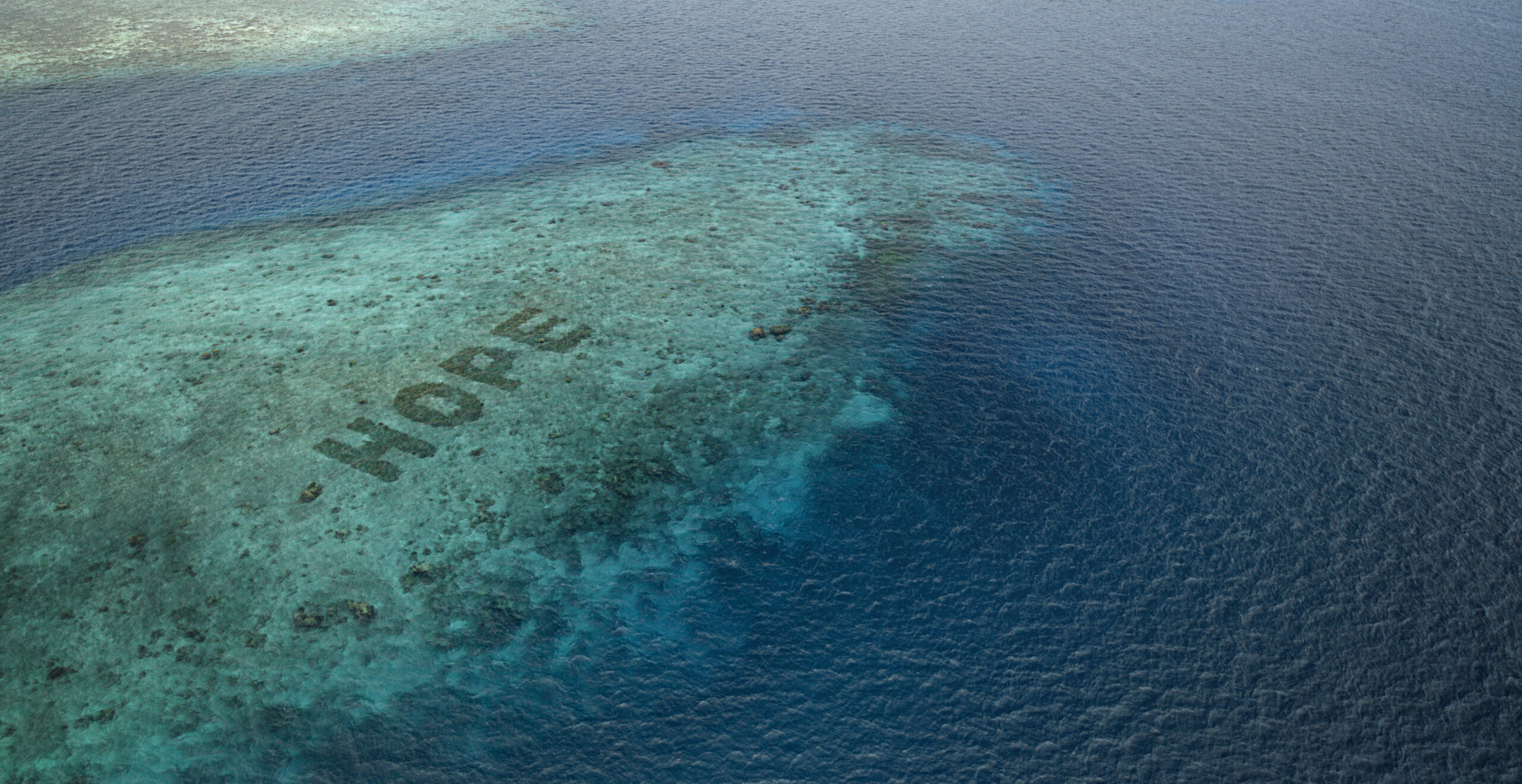 The SHEBA Hope Reef has been regrown to spell the word ‘HOPE’ to drive awareness. Credit: SHEBA
The SHEBA Hope Reef has been regrown to spell the word ‘HOPE’ to drive awareness. Credit: SHEBA
Working in tandem with other marine biologists who replenish coral through breeding and replanting them, scientists are attempting to determine which methods of conservation and restoration are the most effective. “We have the opportunity to quite rapidly rebuild small areas of reef,” Simpson says, “and offer acoustic enrichment to the areas that have been hit the worst.”
Wherever he dives, he realizes, “We are changing the soundtrack of the ocean through overfishing, climate change and poor environmental protection.” He has his work cut out for him: “It’s our gift to change the soundtrack of the ocean in this generation, but to change it for the better, not the worse.”
The new insights call for noise protection. “Noise pollution is also a problem when we run the experiments,” Simpson realized. “Which made us investigate, what’s the noise doing to the fish down there?”


Become a sustaining member today!
Join the Reasons to be Cheerful community by supporting our nonprofit publication and giving what you can.
He found that motorboat noise causes certain fish not to feed their young as well and prevents larvae from developing, which has an obvious solution: “We can keep boats away from breeding grounds and nurseries. And new technology improves the sound outputs of boat engines — modern engines are far quieter.”
Simpson does not gloss over the fact that we’re facing a “bumpy” next few decades. “But the future is still totally in our hands,” he says, “and the direction of travel looks promising.”
At COP27 he was asked “whether this was all actually just a waste of time in the long term, delaying the inevitable.” He responded that five years ago, he might have feared that he and his colleagues were just prolonging the death of coral reefs. “But the global data indicates there is a better future ahead. You might say that coral reefs are the first ecosystems we could lose,” he admits. “But that then makes them the first ecosystems we could save, and if we can save coral reefs, we can save anything.”
The post A Healthy Coral Reef Is a Symphony appeared first on Reasons to be Cheerful.
How Do You Say ‘Danger’ in Sperm Whale Clicks?
This is part one of a two-part series. Read part two here.
Sperm whales don’t sing melodious, moaning whale songs like their humpback cousins. The biggest predator on the planet communicates in clicks, called codas. Some compare the sounds to popping popcorn or frying bacon in a pan. For CUNY biologist David Gruber, it resembles “morse code or techno music.”
Gruber, the founding president of Project CETI, the Cetacean Translation Initiative, often listens for hours in his New York office to the sperm whale chats his team has recorded in the Eastern Caribbean.
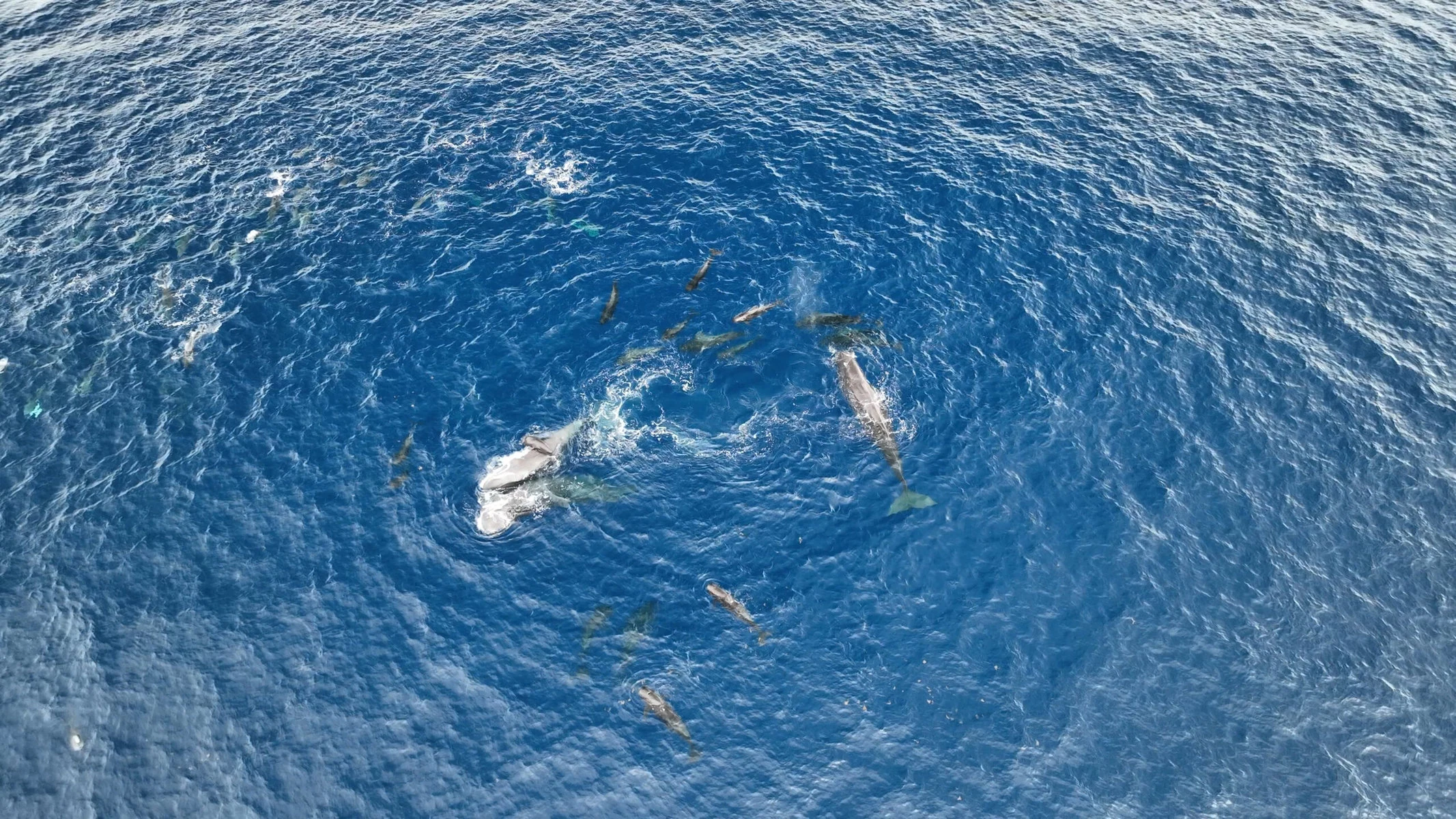 Project CETI records sperm whale codas around the Eastern Caribbean island of Dominica. Courtesy of Project CETI
Project CETI records sperm whale codas around the Eastern Caribbean island of Dominica. Courtesy of Project CETI
CETI focuses on sperm whales for several reasons. One reason is that it can build on the audio recordings that whale biologist Shane Gero has already been collecting for 15 years with the Dominica Sperm Whale Project. Gero was able to show that sperm whale families have different dialects, much like British and American English. “Another reason is that the sperm whale has been vilified as a killer, Moby Dick as a leviathan,” Gruber says. “Meanwhile it could be one of the most intelligent, sophisticated communicators on the planet.”
While the humpback whales sing their soprano songs primarily for mating, sperm whales are communicating to socialize and exchange information. CETI has already discovered that the communication patterns are complex. “Their codas are clicks, they are like ones and zeros, which is very good for cryptographers,” Gruber explains. “The combination of advanced machine learning and bioacoustics is slated to be the next microscope or telescope in terms of our ability to really listen more deeply and understand life at a new level.”
Reasons to Be Cheerful · Sperm Whales
CETI’s team operates a giant whale-recording platform from a 40-foot sailboat off the coast of Dominica, a volcanic island in the Caribbean with a stable sperm whale population. Both by tagging the whales and installing whale listening stations with microphones dangling deep down into the ocean on floating buoys, CETI is recording several terabytes of data every month. The scientists are creating a three-dimensional interactive map of the whales within a 20-kilometer radius, combining sounds with data such as the whales’ heart rates.
The post How Do You Say ‘Danger’ in Sperm Whale Clicks? appeared first on Reasons to be Cheerful.
Generating Life on the Baja Peninsula, One Mangrove at a Time
This story was originally published by Hakai Magazine.
The sun sits low in the sky as David Borbón walks from one young mangrove to another, treading carefully so as not to disturb their roots. A golden glow lights the plants as he delicately checks for flowers and new growth, removing strands of dried algae and seagrass that accumulate on the saplings with the coming and going of tides. Every so often, he lets out a joyful cry upon finding a new propagule — a small, green bean–shaped seedling — growing on a tree he has planted: “My grandchild!” He takes out his phone to capture a picture of the new family member. It has taken him over a decade to get to this moment — a shoreline filled with thriving mangroves where before there was only sand — his devotion to his work unwavering.
Back in his boat, we slowly navigate the narrow channels from Borbón’s mangroves to his nearby home in the small fishing community of Campo Delgadito, mindful of our course with the dropping tide. Shorebirds scurry on the exposed mudflats, digging for their next meal. Situated on the Pacific coast about halfway down the peninsula of Baja California, Mexico, El Delgadito — “the little narrow one” — is a long spit of land jutting northwest into the mouth of Laguna San Ignacio. It’s home to 54 permanent residents, with up to 85 inhabitants during the most important fishing seasons.
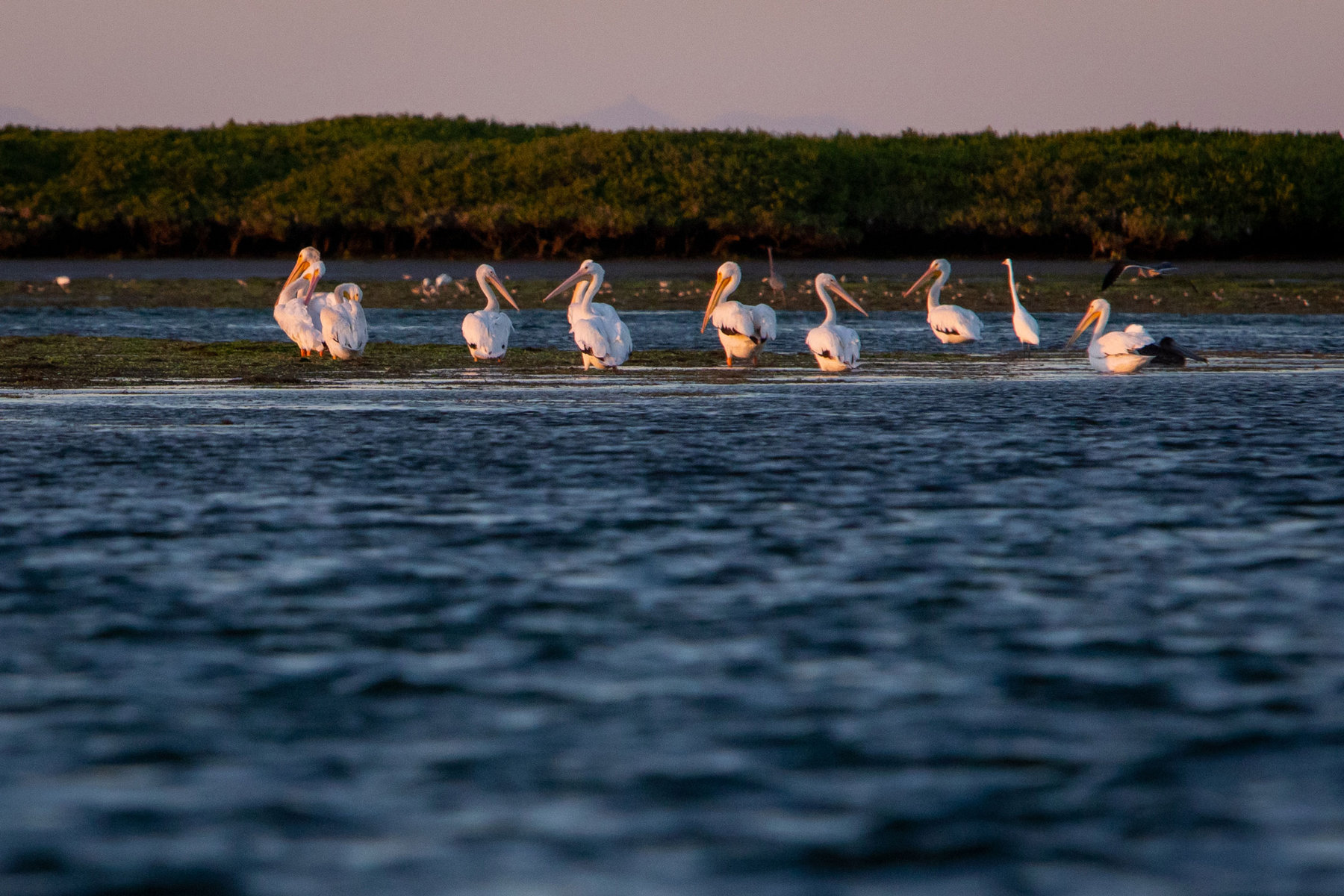 White pelicans rest on a sandbar exposed at low tide. Behind them, scores of shorebirds forage for food. Over 200 bird species have been identified in Laguna San Ignacio, representing almost half of all the species found in the state of Baja California Sur, Mexico. The mangroves serve as excellent resting places and feeding grounds for many of these species. Credit: Gemina Garland-Lewis
White pelicans rest on a sandbar exposed at low tide. Behind them, scores of shorebirds forage for food. Over 200 bird species have been identified in Laguna San Ignacio, representing almost half of all the species found in the state of Baja California Sur, Mexico. The mangroves serve as excellent resting places and feeding grounds for many of these species. Credit: Gemina Garland-Lewis
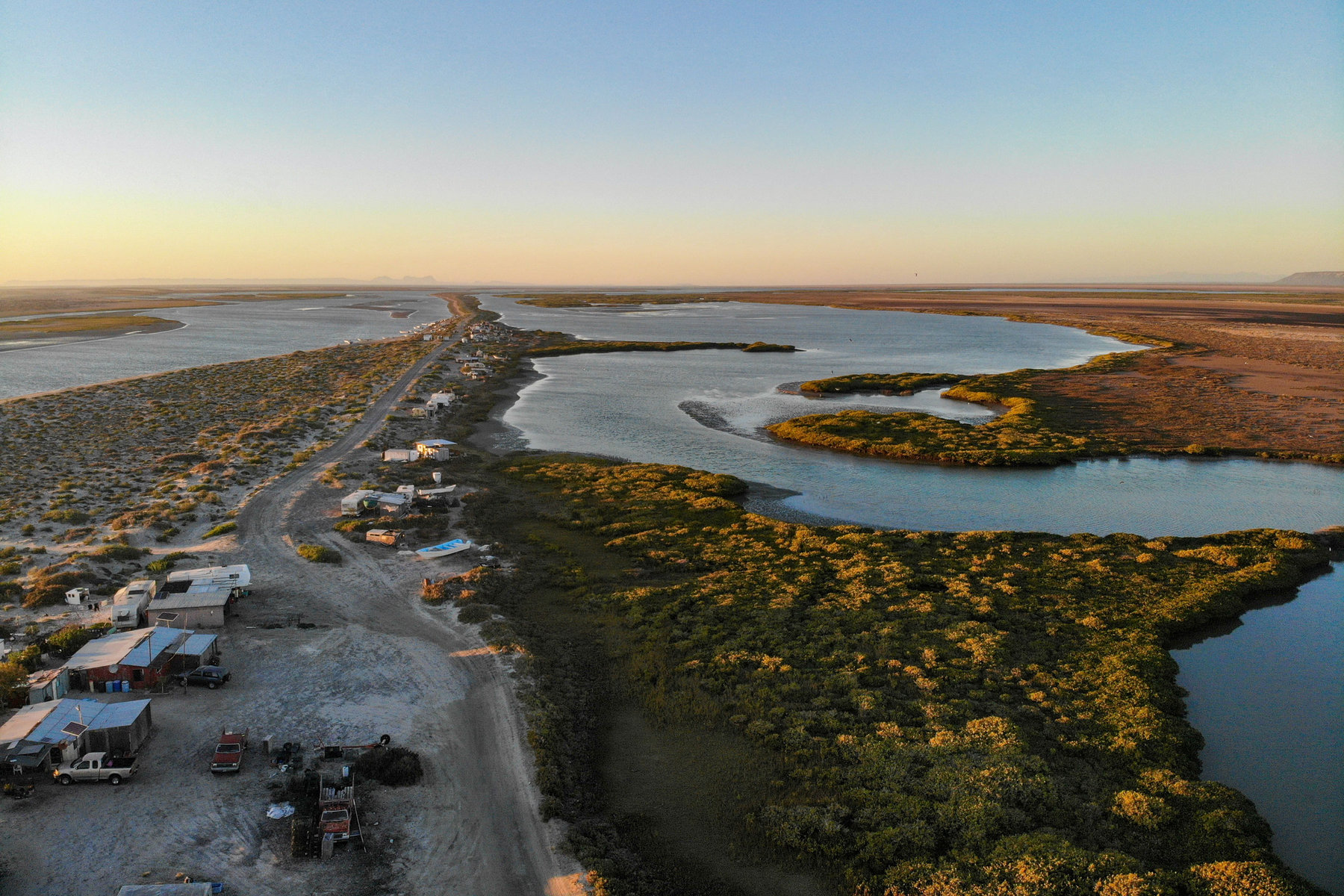 To the left of Campo Delgadito, Mexico, lies the Pacific Ocean and many of the small islets where David Borbón focuses his work. On its right, mangroves grow right up and into residents’ backyards. The community is located at the southern entrance of Laguna San Ignacio, part of the Whale Sanctuary of El Vizcaíno. The sanctuary is an important site for gray whales during their birthing and breeding season and is a UNESCO World Heritage Site. Credit: Gemina Garland-Lewis
To the left of Campo Delgadito, Mexico, lies the Pacific Ocean and many of the small islets where David Borbón focuses his work. On its right, mangroves grow right up and into residents’ backyards. The community is located at the southern entrance of Laguna San Ignacio, part of the Whale Sanctuary of El Vizcaíno. The sanctuary is an important site for gray whales during their birthing and breeding season and is a UNESCO World Heritage Site. Credit: Gemina Garland-Lewis
Borbón first arrived in El Delgadito as a young man in 1980, and he returned seasonally for the fishing — lobster, sea bass, halibut and clams. “[Back then], mangroves were just branches that were in the way of navigating to go fishing. I didn’t have the slightest idea of their importance,” he recalls. By the time he permanently settled in the community in the early 2000s, he was hearing stories of overfishing, even in this remote area. Fishermen boated farther, used more gear and more gas, yet still came back with smaller catches and smaller fish. Borbón and his wife, Ana María Peralta, could see the changes but weren’t sure what to do. A conversation with their daughter, who was away at university, gave them insight into their next steps. She told them what she had been learning about mangroves: how they prevented coastal erosion, stored carbon and provided a nursery habitat for myriad fish and crustacean species, many the same as those Borbón and other fishermen in El Delgadito were catching. The trees he had barely paid any attention to became the sole focus of his attention.
Gemima Garland-Lewis
Tens of thousands of shells of callo de hacha, the pen shell clam, are piled deep surrounding the dump in Laguna San Ignacio. This species is one of several clams that form an important part of the income in this area. Many in El Delgadito, as the community is known by those who live there, believe that their children will not be able to make a living fishing as they have done. “We are taking and not putting back,” says one of El Delgadito’s fishermen.
Four species of mangroves — red, white, black and sweet — grow throughout the state of Baja California Sur, which covers the lower half of the Baja California peninsula, and elsewhere in tropical and subtropical latitudes around the world. Mangroves are perhaps not what jumps to mind in desert ecosystems like that of El Delgadito, however, which sits less than one-half of one degree south of all mangroves’ northern limit in the entire eastern Pacific. Mangroves here grow short and stunted compared with their tropical counterparts — even when fully developed, a species that reaches over 25 meters in height in the tropics may barely make two meters in this region. Their small stature doesn’t make them any less mighty from the standpoint of the ecological services they provide. Studies in Baja California Sur and the adjacent Gulf of California have shown that not only do fisheries landings increase in areas where there are more abundant mangroves but also that these mangroves match or even outperform tropical mangrove ecosystems in their carbon sequestration abilities.
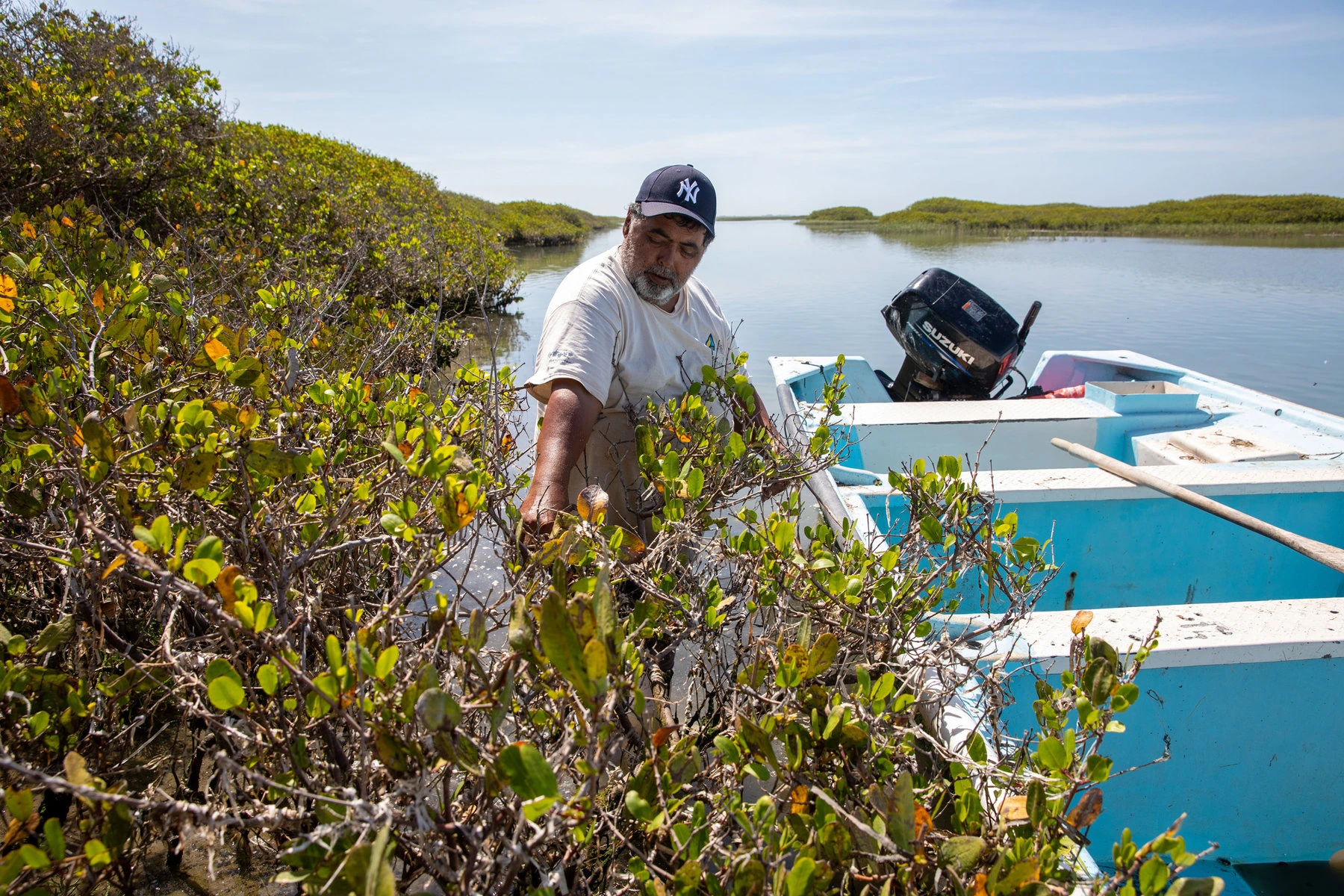 Borbón stops to clean debris off some of the oldest mangroves in the area, estimated to be around 250 years old. Shortly after learning about mangroves from his daughter, a serendipitous visit from a researcher doing her thesis project on the vulnerability and resilience of the mangroves on Baja California’s Pacific coast provided him an opportunity to understand more about the life cycles of the different mangrove species and the threats they are facing. When people in his community told him he was crazy for starting to plant mangroves, she offered encouragement. To this day, he still keeps a copy of her thesis in his home. Credit: Gemima Garland-Lewis
Borbón stops to clean debris off some of the oldest mangroves in the area, estimated to be around 250 years old. Shortly after learning about mangroves from his daughter, a serendipitous visit from a researcher doing her thesis project on the vulnerability and resilience of the mangroves on Baja California’s Pacific coast provided him an opportunity to understand more about the life cycles of the different mangrove species and the threats they are facing. When people in his community told him he was crazy for starting to plant mangroves, she offered encouragement. To this day, he still keeps a copy of her thesis in his home. Credit: Gemima Garland-Lewis
Crushed by negative news?
Sign up for the Reasons to be Cheerful newsletter.
[contact-form-7]
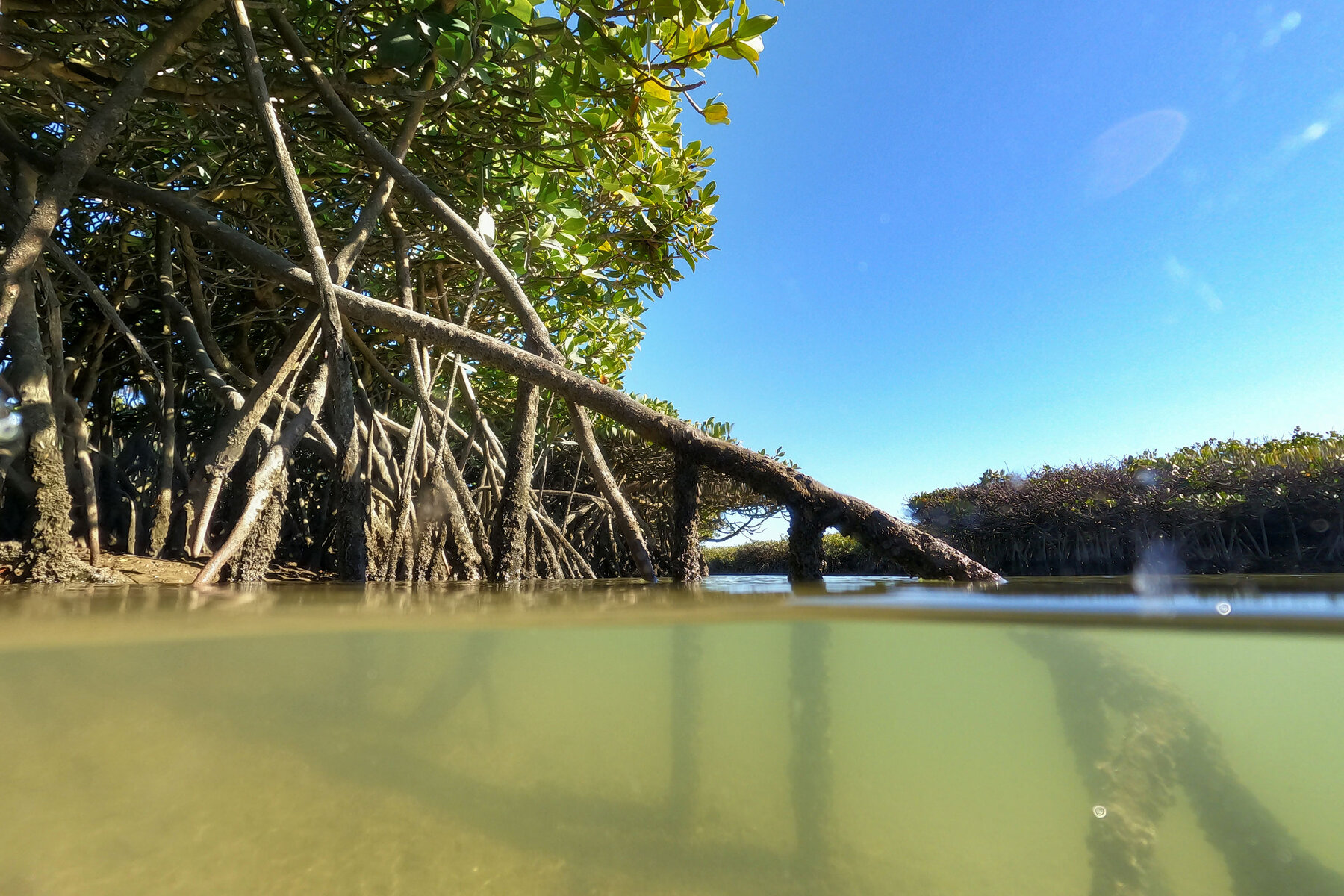 The “prop” roots of the red mangrove. Studies show that Baja California Sur’s desert mangroves grow on top of their own root remains, forming a type of peat that serves as a highly efficient environment for carbon sequestration. This peat extends to depths of more than three meters, and core samples indicate that, in some areas, it has been storing carbon at the same rate for over 5,000 years. It has also historically provided mangrove ecosystems in this region with a mechanism for keeping pace with sea level rise. Credit: Gemima Garland-Lewis
The “prop” roots of the red mangrove. Studies show that Baja California Sur’s desert mangroves grow on top of their own root remains, forming a type of peat that serves as a highly efficient environment for carbon sequestration. This peat extends to depths of more than three meters, and core samples indicate that, in some areas, it has been storing carbon at the same rate for over 5,000 years. It has also historically provided mangrove ecosystems in this region with a mechanism for keeping pace with sea level rise. Credit: Gemima Garland-Lewis
Baja California Sur is the least densely populated state in all of Mexico, and extreme loss of mangroves is concentrated in the urban spaces of La Paz and Los Cabos. Construction of fishing camps around El Delgadito in the 1980s led to the removal of some of the area’s mangroves, but nothing has done as much damage in recent years as climate change, says Borbón. Higher tides and stronger currents undercut the sandbars that support the mangroves, carving underwater caves that eventually cause the entire root system to collapse, especially among younger trees.
Credit: Gemima Garland-Lewis
Mature mangroves in this desert ecosystem barely stand out in the background, size-wise. El Delgadito sits less than one half of one degree south of all mangroves’ northern limit in the entire eastern Pacific, making even these centuries-old trees look short and stunted. Although mangroves make up less than one percent of the terrestrial area of the Baja California peninsula, they store about 28 percent of the total below-ground carbon in this arid climate. This makes them by far the biggest carbon sink in the region, a feature that Borbón and his wife, Ana María Peralta, know will be monumental in tackling the local impacts of climate change.
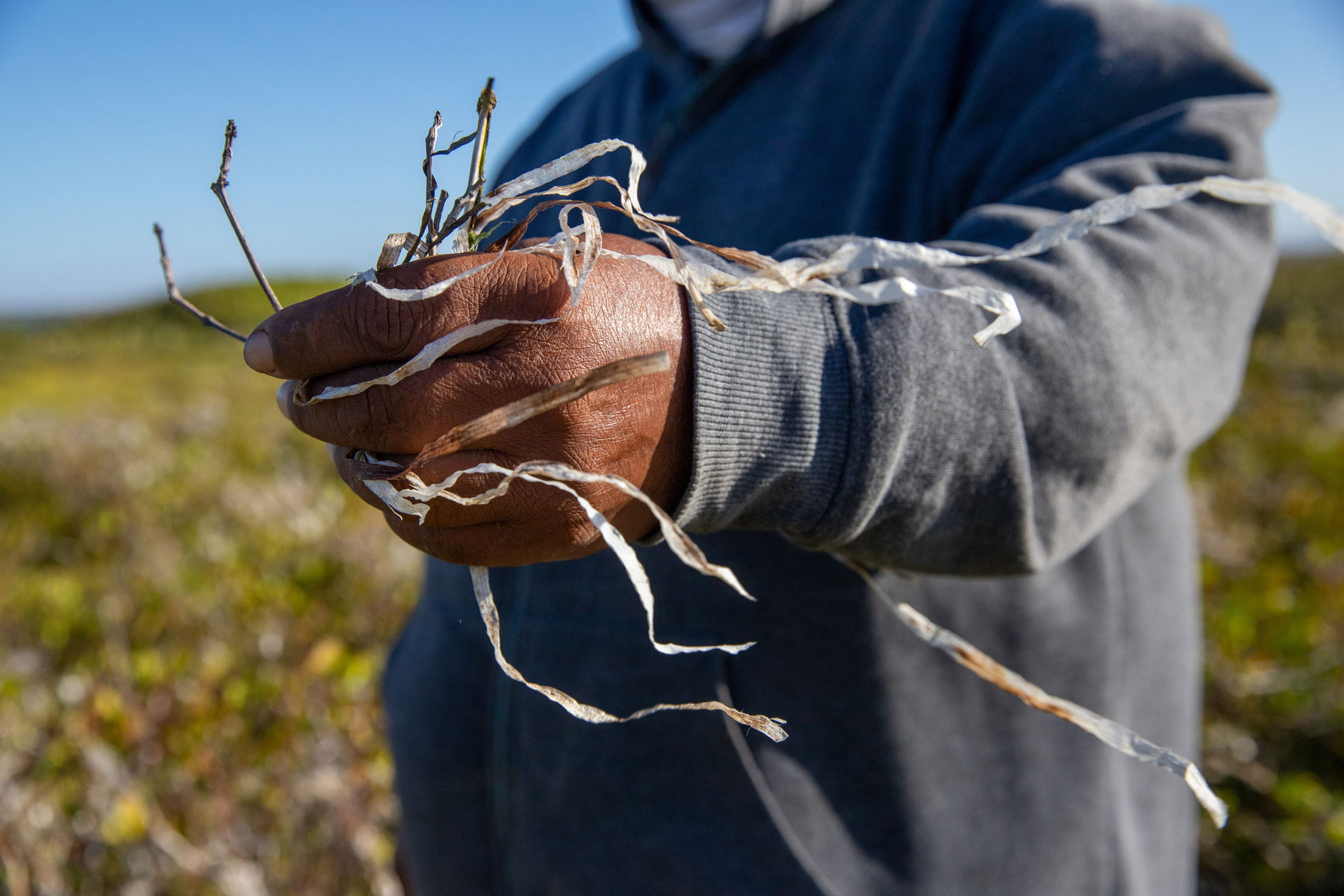 Rising sea temperatures trigger mass die-offs of seagrasses, which are swept by the currents onto mangroves, often smothering them or ripping their young roots from the substrate. Borbón painstakingly removes these deposits both from trees he has planted and from those that have grown naturally. Credit: Gemima Garland-Lewis
Rising sea temperatures trigger mass die-offs of seagrasses, which are swept by the currents onto mangroves, often smothering them or ripping their young roots from the substrate. Borbón painstakingly removes these deposits both from trees he has planted and from those that have grown naturally. Credit: Gemima Garland-Lewis
Though never formally trained in the sciences, Borbón has an incredible aptitude and devotion toward experimentation. Taking what he knew from being raised in an agricultural region of Mexico, he carried out early iterations of his work growing mangroves in a greenhouse. He soon found that the young trees couldn’t handle the shock of being transplanted, so he and Peralta started “playing scientists,” as he calls it, planting propagules in the places surrounding El Delgadito where they ultimately wanted them to grow. Over the years, they have perfected the process to a point where they may very well know more than anyone else about growing mangroves in this desert ecosystem, though they never stop experimenting with new ideas.
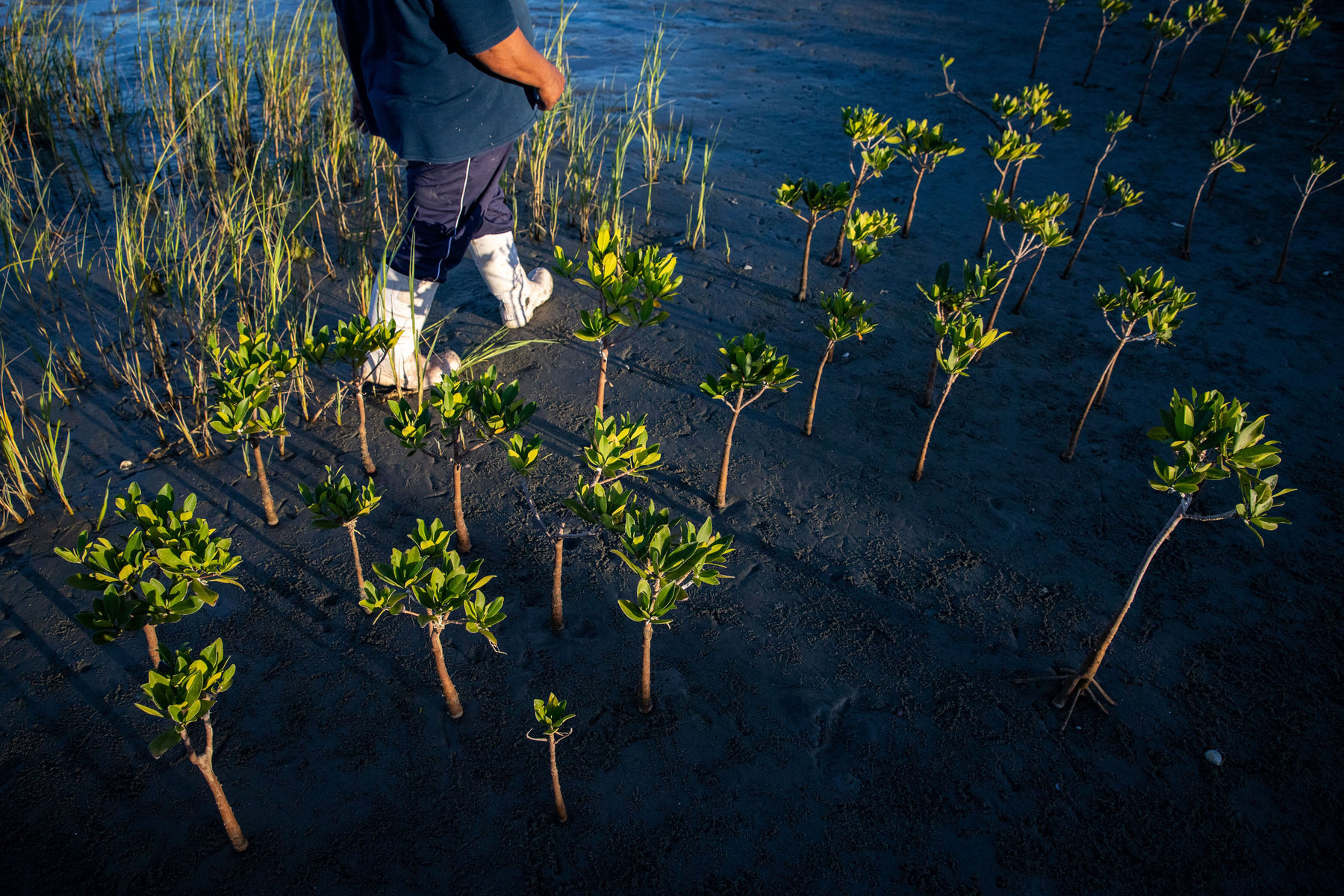 Borbón checks on some of his two-year-old trees. When he first started, he’d experiment with spacing between the plants as well as their distance from the high tideline. He also tested how wind, current, waves, and cardinal direction to these natural forces changed his success. “Do you know what the most important thing is?” he asks me. “Not science, not technology. Heart.” Credit: Gemima Garland-Lewis
Borbón checks on some of his two-year-old trees. When he first started, he’d experiment with spacing between the plants as well as their distance from the high tideline. He also tested how wind, current, waves, and cardinal direction to these natural forces changed his success. “Do you know what the most important thing is?” he asks me. “Not science, not technology. Heart.” Credit: Gemima Garland-Lewis
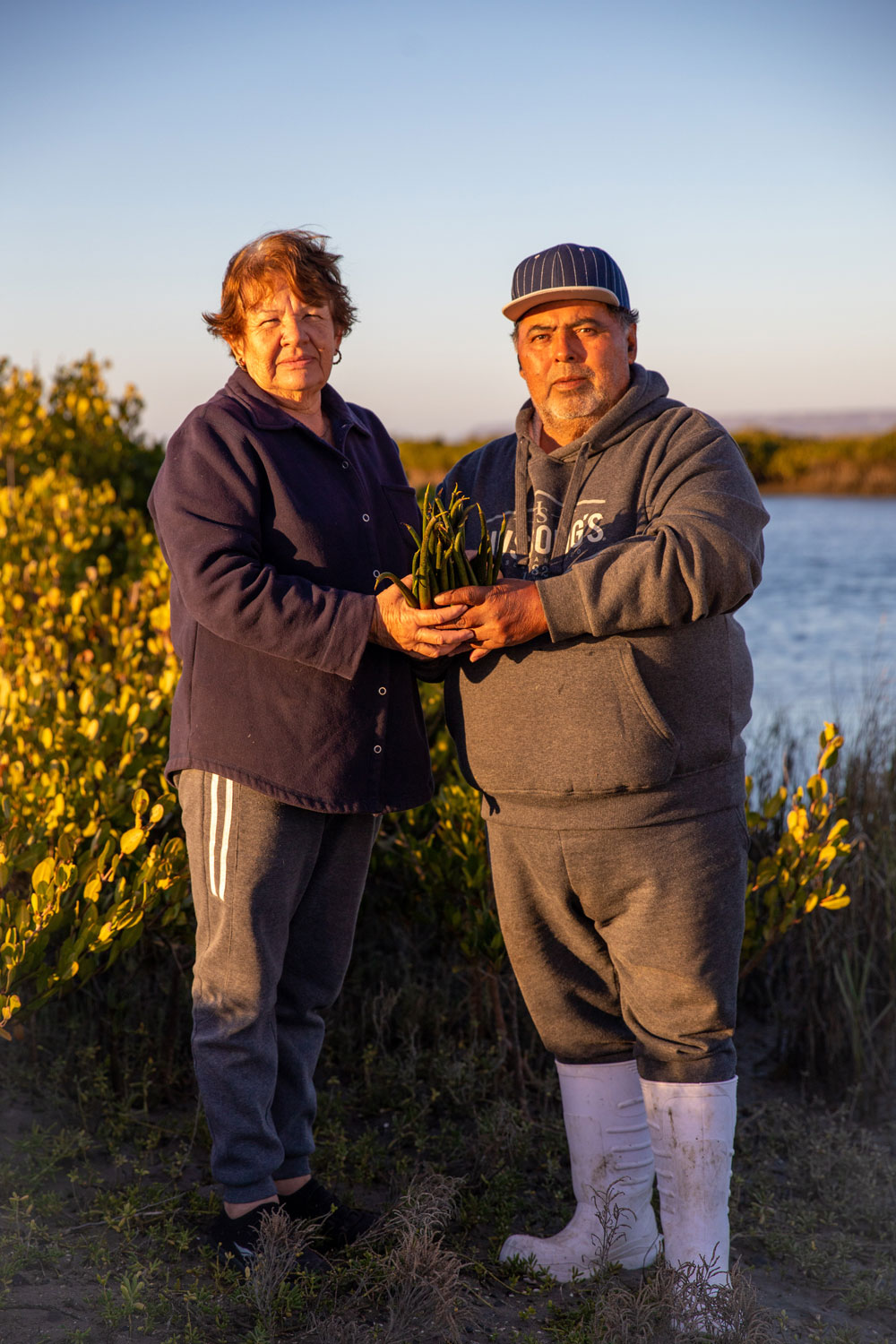 Peralta and Borbón with the mangroves across the dirt road from their home. In recent months, Borbón has been invited to present at international conferences, heard pitches from the World Bank, and been asked to begin a train-the-trainers program for others trying to restore mangroves in their communities. “We are not talking about sustainability,” he says, “we are talking about regeneration — and it’s worth fighting for, whatever is required, because it’s necessary. It’s very necessary in these communities to avoid emigration, to create opportunities for both young and old, for men and women, for people on the coast and people on ranches in the sierras [mountain ranges], because this is wonderful.” Credit: Gemima Garland-LewisToday, Borbón and Peralta have a team of over 20. It is paid work—the only of its kind in this area that isn’t from fishing. Funding now comes from partnership with a US-based environmental services company instead of from the couple’s own pocket. Their team members range in age from 19 to 60, though the majority are youth. “Our focus is more with the younger than the older generations,” explains Peralta. “You can’t change what they’re accustomed to. But the young people are learning. They’re the future of here, the future of Mexico, the future of everything, to continue with the mangroves.”
Peralta and Borbón with the mangroves across the dirt road from their home. In recent months, Borbón has been invited to present at international conferences, heard pitches from the World Bank, and been asked to begin a train-the-trainers program for others trying to restore mangroves in their communities. “We are not talking about sustainability,” he says, “we are talking about regeneration — and it’s worth fighting for, whatever is required, because it’s necessary. It’s very necessary in these communities to avoid emigration, to create opportunities for both young and old, for men and women, for people on the coast and people on ranches in the sierras [mountain ranges], because this is wonderful.” Credit: Gemima Garland-LewisToday, Borbón and Peralta have a team of over 20. It is paid work—the only of its kind in this area that isn’t from fishing. Funding now comes from partnership with a US-based environmental services company instead of from the couple’s own pocket. Their team members range in age from 19 to 60, though the majority are youth. “Our focus is more with the younger than the older generations,” explains Peralta. “You can’t change what they’re accustomed to. But the young people are learning. They’re the future of here, the future of Mexico, the future of everything, to continue with the mangroves.”
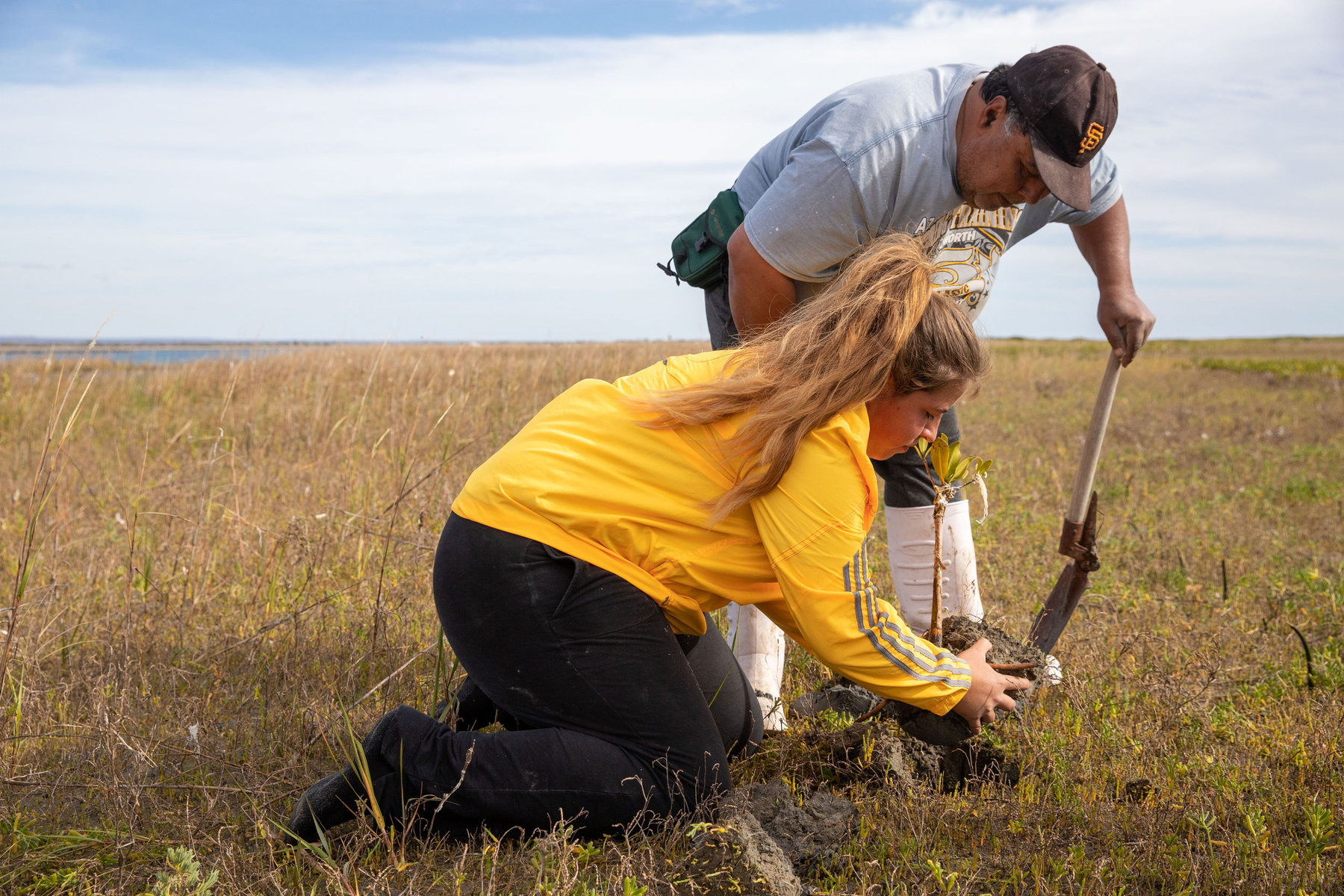 Borbón helps Victoria, one of his core team members, transplant a year-old mangrove. He is worried he planted last year’s trees too close together and is experimenting with moving them farther apart while they are still young. These year’s propagules will be placed farther apart from the get-go. Credit: Gemima Garland-Lewis
Borbón helps Victoria, one of his core team members, transplant a year-old mangrove. He is worried he planted last year’s trees too close together and is experimenting with moving them farther apart while they are still young. These year’s propagules will be placed farther apart from the get-go. Credit: Gemima Garland-Lewis
Credit: Gemima Garland-Lewis
Borbón and Peralta soak the propagules for eight to 11 days in fresh water to stimulate the growth of root nodules. Then, with their team of young community members, they count the propagules and place them in buckets to take into the field, doing quality control along the way. Borbón has learned over the years that it’s best to target those that have developed to the point where they are still attached to the parent tree but fall off easily, like ripe fruit.
During the summer months, they take scouting trips to monitor the development of new red mangrove propagules and tend young trees. Come October, they harvest the propagules and soak them in fresh water for just over a week. At the restoration site, one person walks a transect line using a wooden tool to punch a small hole into the sediment while another follows with the propagules. It takes just a second to plant each one, and over the past 12 years they’ve planted an estimated 1.2 million and watched stretches of bare sand transform to green. It’s still too soon to see the impact on local fisheries, but Borbón has no shortage of hope: “The fact that we plant mangroves generates life. We expand the possibilities of helping nature by allowing them to naturally repopulate and recover.” He adds that the “constant attack” from fishing limits recovery, but he’s not deterred. “That is why it is so important that we continue with our efforts.”
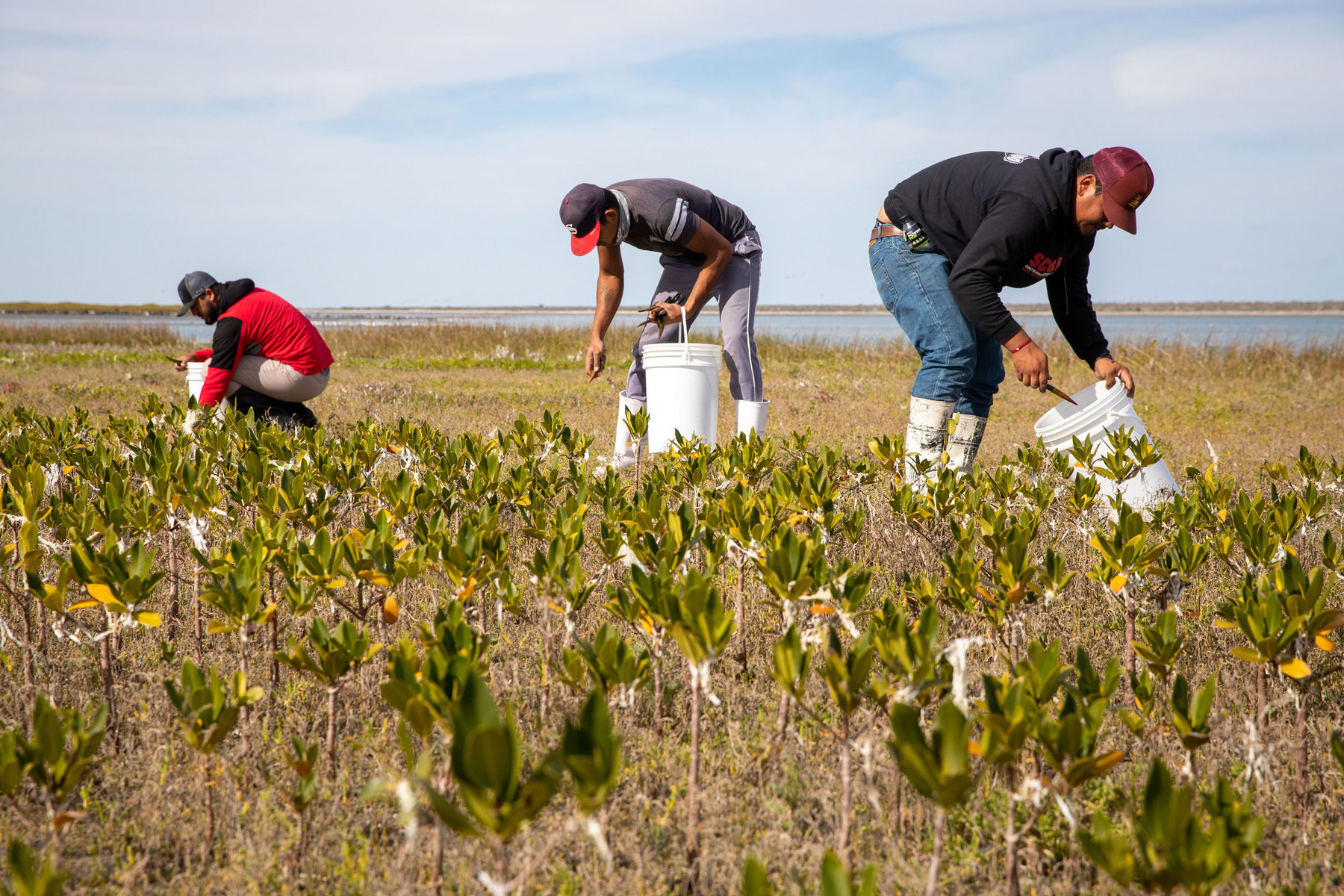 Working as a team, community members of El Delgadito plant new red mangrove propagules alongside one-year-old trees from last season’s work. Borbón and Peralta have found that, aside from the direct investment in mangroves, hiring youth also takes away some of the impact of local fisheries by providing people with an economic alternative. “We need jobs for young people. Because many can’t get an education, and they get married very young and want to do the same as their parents, they become fishermen and fish as much as they can. They need jobs, another type of work,” Peralta explains. Credit: Gemima Garland-Lewis
Working as a team, community members of El Delgadito plant new red mangrove propagules alongside one-year-old trees from last season’s work. Borbón and Peralta have found that, aside from the direct investment in mangroves, hiring youth also takes away some of the impact of local fisheries by providing people with an economic alternative. “We need jobs for young people. Because many can’t get an education, and they get married very young and want to do the same as their parents, they become fishermen and fish as much as they can. They need jobs, another type of work,” Peralta explains. Credit: Gemima Garland-Lewis
Credit: Gemima Garland-Lewis
Areas that started as bare sand quickly developed vegetation once the young red mangroves stabilized the soil. Species like Salicornia and white mangroves sprout on their own, forming a cover of green.
In early September 2022, Hurricane Kay made landfall several hours north of El Delgadito. Colder surface waters on the Pacific coast of Baja California have historically made it rare for a storm system to make its way this far north along the peninsula. Mangroves have been shown to absorb 70 to 90 percent of a wave’s energy, and the storm put Borbón and Peralta’s work to the test. Areas that had their first mangroves planted 10 years prior were destroyed, leaving almost nothing but sand where the highest branches once reached overhead. The couple was devastated, and Borbón’s eyes filled with tears when he broke the news to me. He estimates that, in addition to those first trees he planted, close to 300,000 young trees were lost. Soon after, a marine biologist friend brought an impact assessment expert from the US National Oceanic and Atmospheric Administration to see El Delgadito. She looked at the proximity of the mangroves that had been destroyed to the community and told the couple that their work very likely prevented the loss of much of their community.
Crushed by negative news?
Sign up for the Reasons to be Cheerful newsletter.
[contact-form-7]
The researcher’s comments provided hope for the future and validation to Borbón and Peralta that their efforts weren’t for naught. Today, looking out from the driver’s seat in his small boat, Borbón envisions what is to come. “My dream for this region has no limits; what can be done is wonderful. We have dedicated ourselves to conservation because it is very clear to me that the day mangroves end, life ends in this region.” Tomorrow, he’ll wake at dawn and drink a cup of coffee before driving down the road to his boat, never missing a beat in his dedication to making his vision a reality.
This article first appeared in Hakai Magazine and is republished here with permission. Read more stories like this at hakaimagazine.com.
The post Generating Life on the Baja Peninsula, One Mangrove at a Time appeared first on Reasons to be Cheerful.
The Legendary Ocean Explorer Protecting ‘Hope Spots’ Around the World
Despite celebrating her 88th birthday last August, Sylvia Earle seems to whirl around the globe faster than a hurricane gathering strength. She still travels about 300 days of the year and just returned from the Cayman Islands, Brazil, Mozambique, Mexico, Antarctica and Europe. “I feel like an octopus with all arms fully engaged,” she says about her workload. “If a child is about to fall off a 10-story building and you are in a position to catch it, you’ll do everything in your power to be positioned just so you can save it. You don’t look away and have a cup of tea in the meantime.”
Earle’s sense of urgency is due to her unique position in history. The first woman to dive with scuba gear in the early 1950s, the first person to walk on the ocean floor 1250 feet under the surface in 1979, the first female chief scientist of the US National Oceanic and Atmospheric Administration (NOAA) in 1990, she has explored the oceans deeper and longer than any other woman on the planet. This gave her a front-row seat to the changes occurring below the surface, long before women were welcomed in marine sciences.
Now, when she returns to spots that once brimmed with fish and vibrant corals, she often only finds a gray underwater desert. While about 12 percent of the land around the world is under some form of protection, less than three percent of the ocean is protected.
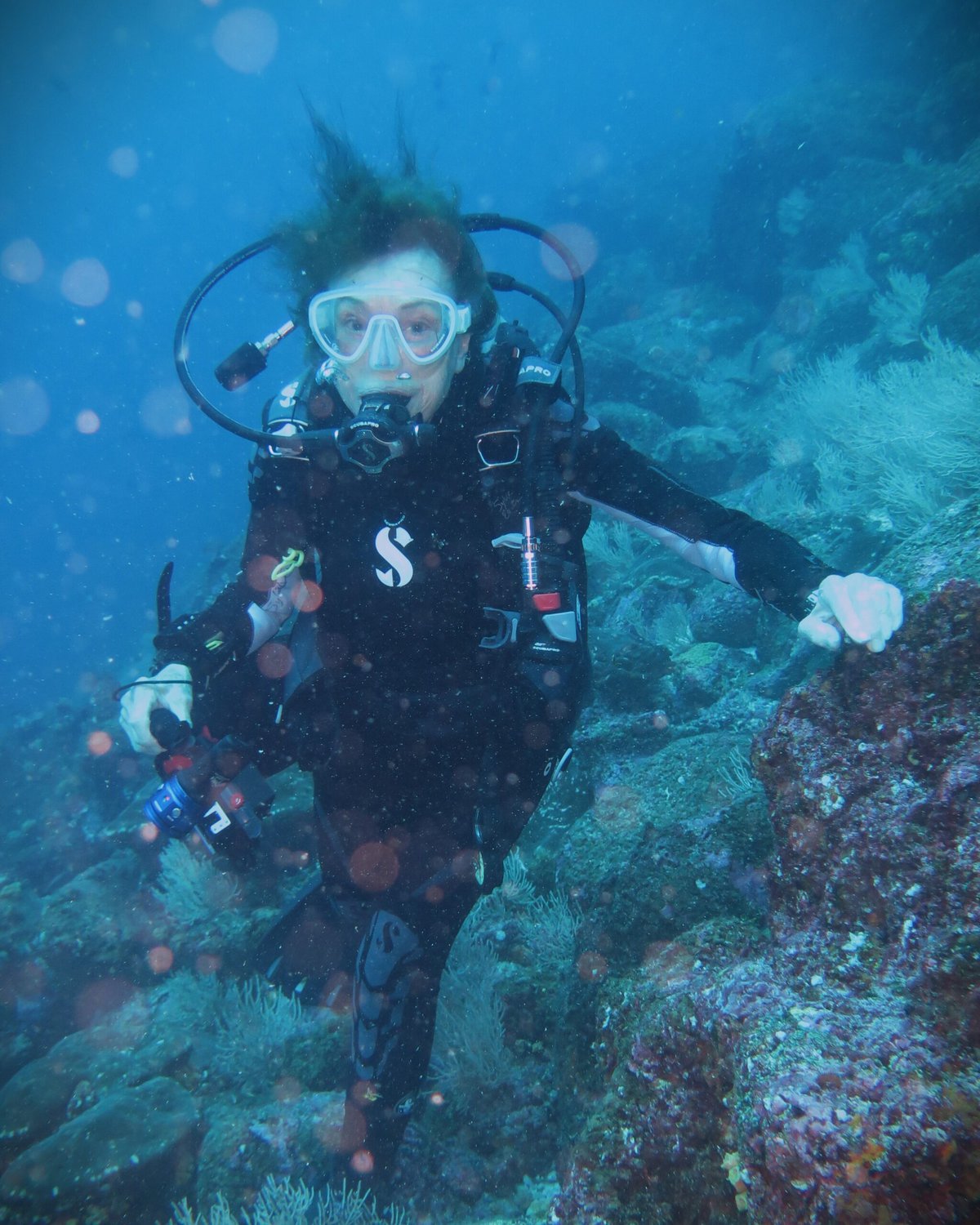 Earle diving in the Galapagos. Credit: Carl Lundin / Mission Blue
Earle diving in the Galapagos. Credit: Carl Lundin / Mission Blue
“Which means 97 percent are open for exploitation,” she says. “We have lost about 90 percent of sharks, tuna, and other fish, and 50 percent of coral.” “Her Deepness,” as the world’s most renowned marine scientist is lovingly called by friends and fans, has been working to change that. In 2009, she started the nonprofit Mission Blue with 19 Hope Spots, defined as “areas critical to ocean health in that they have a significant amount of biodiversity.”
There are now 158 Hope Spots, “and counting,” Shannon Rake, Mission Blue’s Hope Spot Manager, emphasizes. Hope Spots can be as large as the coral triangle in the Eastern Tropical Pacific Sea and as well-known as the Galapagos Islands, or small and quite unknown, like a dozen seamounts off California’s coast. No matter how tiny, Earle is convinced every Spot counts. “Every place, even the small places, makes a difference,“ she insists. “But we need to scale up. We need to get big. Take care of the ocean as if your life depends on it because it does.”
The Harvard-trained marine scientist with a PhD from Duke University has made it her mission to advocate for the ocean. Earle compares the ocean to our heart. “You wouldn’t say you need to protect just three percent or even 30 percent of your heart,” she says. “The oceans are the heart of the planet. Without it, life is not possible.”
Initially, Hope Spots were identified by renowned scientists. But after the 2014 Netflix documentary Mission Blue made her idea popular and people started reaching out to the nonprofit, Earle opened the process up to the public. “We’re overwhelmed by nominations from the public,” Rake admits before she adds, “in a good way!” She receives up to 100 nomination requests per year that are reviewed by a committee.
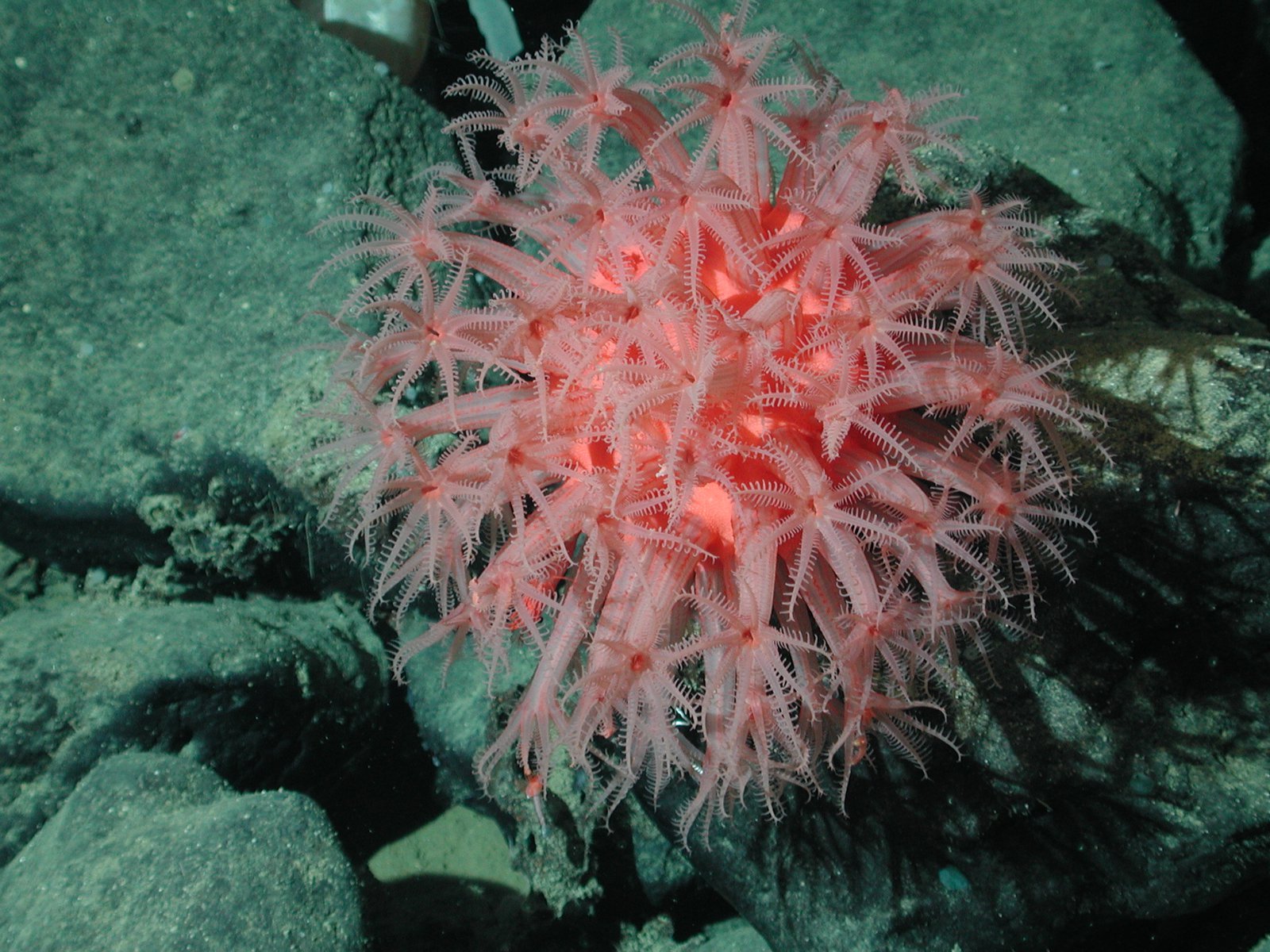 A mushroom coral at Davidson Seamount, California. Credit: NOAA / Monterey Bay Aquarium Research Institute
A mushroom coral at Davidson Seamount, California. Credit: NOAA / Monterey Bay Aquarium Research Institute
While Earle is petite in stature, she maintains a vigorous and outsized optimism. “I think you could get really depressed looking at headlines if you wished to focus on the bad news; there’s plenty of it,” she admits. “If we wait much longer to act on those opportunities we will lose the chance. So this is literally the best time that I can think of in all of history to be alive because just in my lifetime, I’ve witnessed greater insight, greater knowledge, about the fabric of life.”
One Hope Spot is literally just outside the windows of her Alameda, CA, office — the San Francisco Bay. “Admittedly, it’s not exactly pristine,” Earle comments, “but better than it has been in the past because people are coming together to take action and restore its health.”
When she started exploring the seas decades ago, humankind thought the oceans were so vast they could handle any amount of trash, toxic pollutants and fishing boats. Earle was among the first to sound the alarm.


Become a sustaining member today!
Join the Reasons to be Cheerful community by supporting our nonprofit publication and giving what you can.
She was also the one who pointed out that Google Maps should be called “Google Dirt” because it didn’t map the oceans, only the land. Google promptly expanded its program to map the blue.
Some Hope Spots are already fully protected marine areas, and the designation is meant to help keep the protections in place when governments change or funds dry up. At other times, the nomination process for a Hope Spot can help galvanize the support of local governments and environmentalists to put legal protections in place. “Mission Blue is trying to help the local communities and ocean champions to move the needle,” Rake says. “Then we’re trying to maintain that status because as we know, administrations change and can roll back policies. We’re using our collective power and community activism to let elected officials know how important this place is. No, you really shouldn’t build a timber port right here in the migratory pathway of endangered southern right whales. This allows the elected officials to learn more about what’s at stake and what the community wants.”
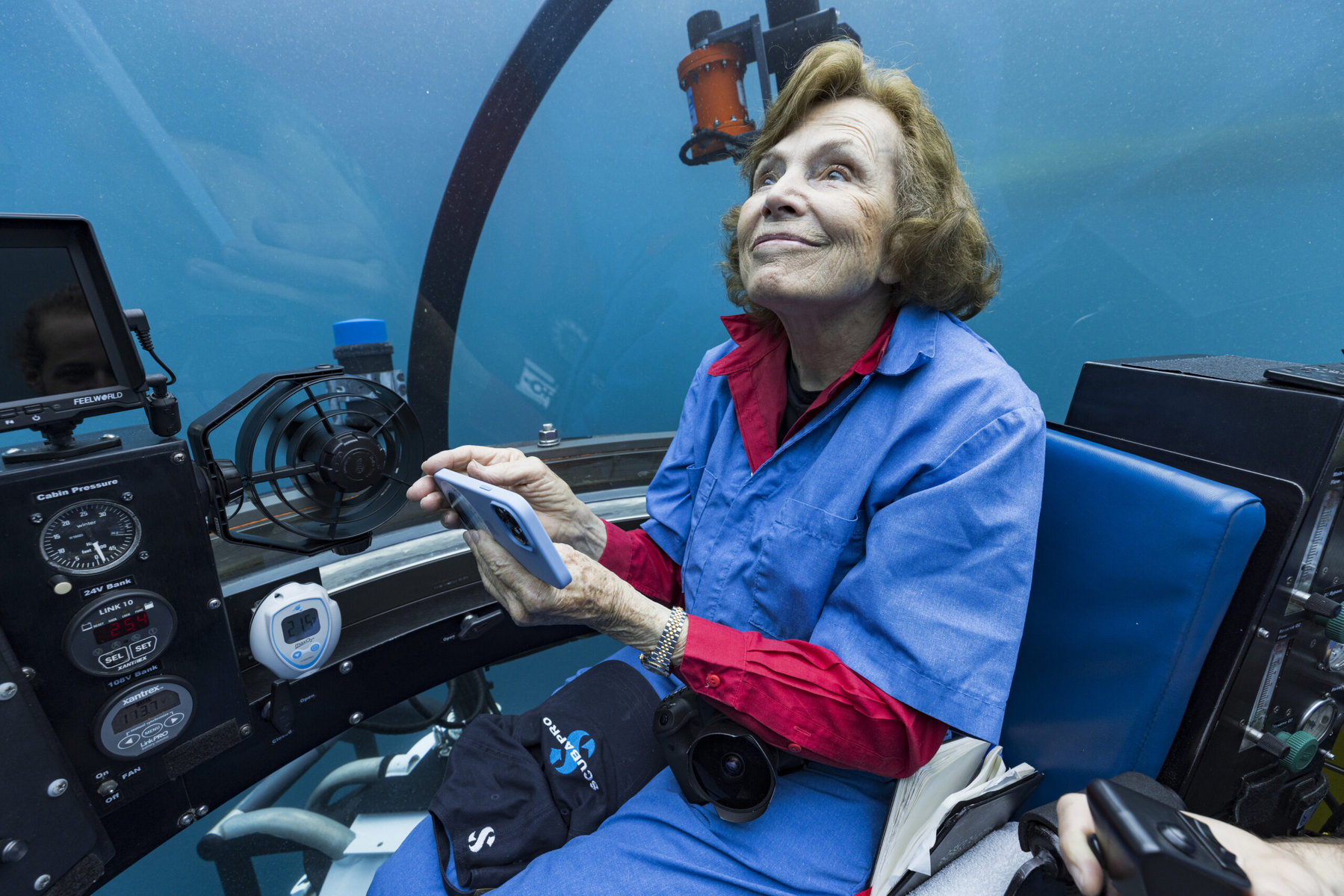 “I feel like an octopus with all arms fully engaged,” says Earle, who still works ambitiously at age 88. Credit: Taylor Griffith / Mission Blue
“I feel like an octopus with all arms fully engaged,” says Earle, who still works ambitiously at age 88. Credit: Taylor Griffith / Mission Blue
For instance, Cabo Pulmo in Mexico was so badly overfished that fishermen kept pulling empty nets from the sea. In the late 1990s, the fishing cooperatives joined forces with scientists, implemented fishing regulations and replaced income from fishing with ecotourism. Through Global Fishing Watch, Mission Blue observed fishing ships leaving the area after protections were put in place. “The tuna industry was very against [the no-take designation] because they thought their catch would decline but it ended up being the reverse,” Rake remembers. “They now see a 25 percent increase in their yield near the protected areas because of the spillover effect when you protect an area.”
The Palmahim Slide in Israel is another example of a Hope Spot that didn’t have any protection before it was nominated. The rare geological formation deep in the Mediterranean Sea, about 20 miles off the Coast of Tel Aviv, is a biodiversity hotspot where catsharks breed and bluefin tuna spawn. “We helped the marine conservationists with letters of support, scientific advisory and communication, and they were able to create a protected area approved by government officials,” Rake explains. “We’re using our international spotlight to really push for protection in these areas.”
“Every Hope Spot is on a different journey,” Rake says, referring to widely varying local regulations. She mentions Shinnecock Bay on Long Island’s South Shore as another example where the Hope Spot designation had a measurable impact. “It was severely degraded, was having red and brown tides,” Rake says. “There has been an absolute incredible change, doing restoration work with clams and oysters.”
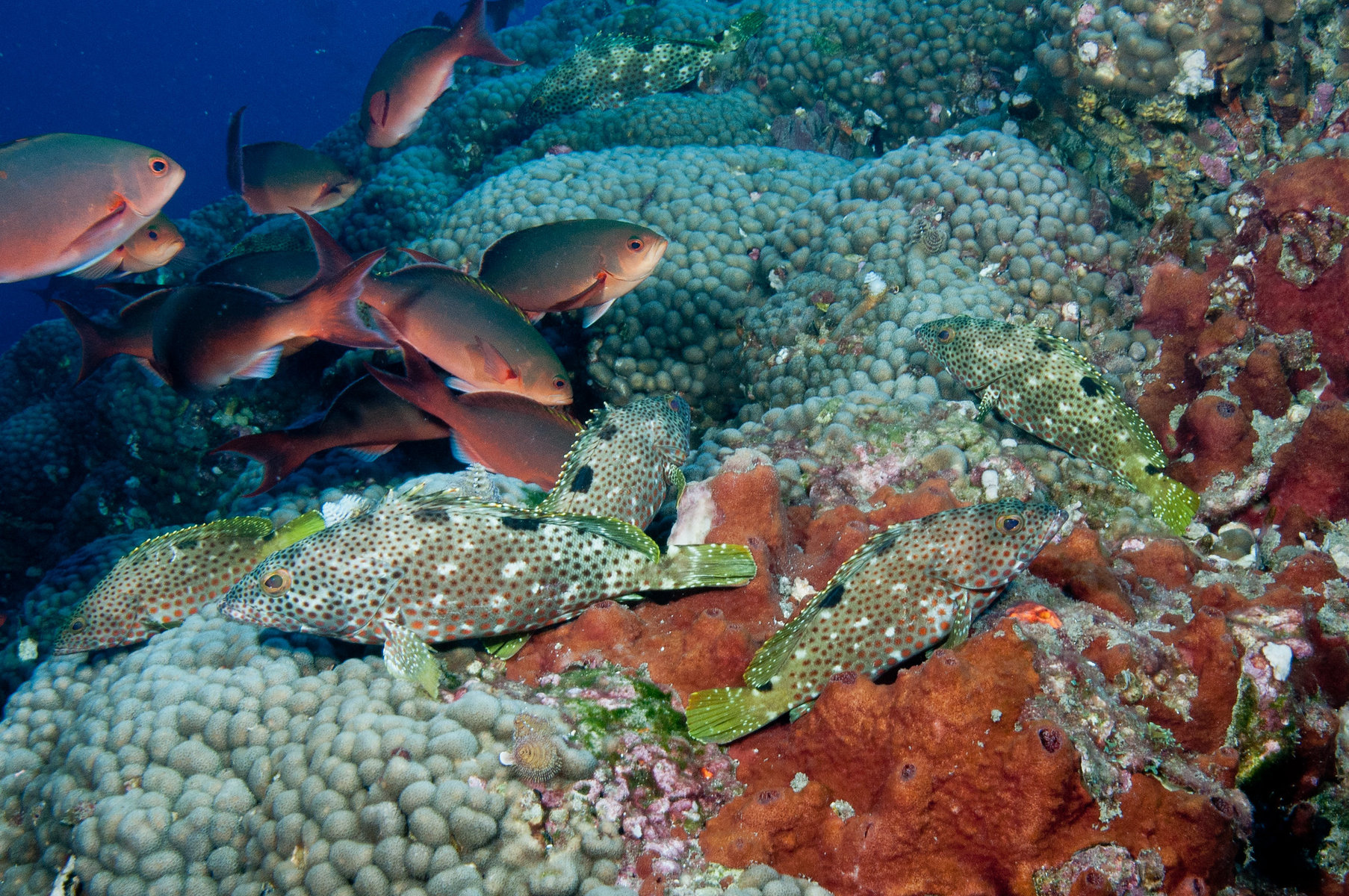 Schools of rock hind and creolefish rest along the reef in Flower Garden Banks National Marine Sanctuary in the Gulf of Mexico. Credit: G. P. Schmahl / Flower Garden Banks NMS
Schools of rock hind and creolefish rest along the reef in Flower Garden Banks National Marine Sanctuary in the Gulf of Mexico. Credit: G. P. Schmahl / Flower Garden Banks NMS
Earle’s favorite Hope Spot might be the Gulf of Mexico. Earle was 12 when her parents moved the family from New Jersey to a beach house in Florida. The ocean became her playground. “It’s where I first took the plunge as a kid and saw what life is like underwater.” It was also in Florida that she first became aware that nature was being destroyed for human consumption.
Mission Blue cooperates with more than 200 ocean conservation groups worldwide, aiming to galvanize local, regional, national and international protection. Some are well known, such as the Ocean Elders, ambassadors for the oceans that include primatologist Jane Gooddall, filmmaker James Cameron, mogul Richard Branson and musician Neil Young. Earle speaks of “creating a network of hope. The idea is to get people who can weigh in at a level that transcends political boundaries.”
While being fully aware of the damage done, Earle keeps coming back to the positive changes. “This past year, some tangible actions have been taken that are cause for optimism,” she says, referring to the UN Ocean Treaty that aims to protect 30 percent of the oceans by 2030 and the Biodiversity Treaty. “The Biodiversity Treaty recognizes that we’re on a downhill slide to lose at least a million species by the end of this century if we keep doing what we’re doing.”
Earle acknowledges, “We are not currently behaving with that kind of intelligence. We’re using the old model of consuming nature without being concerned about the impact on the next 10 years, the next hundred years, the next thousand years.” However, she points out that the numbers of the California condor and other species, including some whales, who were on the brink of extinction have been successfully restored: “We’ve helped get them back to certainly a better place not where they were 500 years ago, but certainly better than they were 50 years ago.”
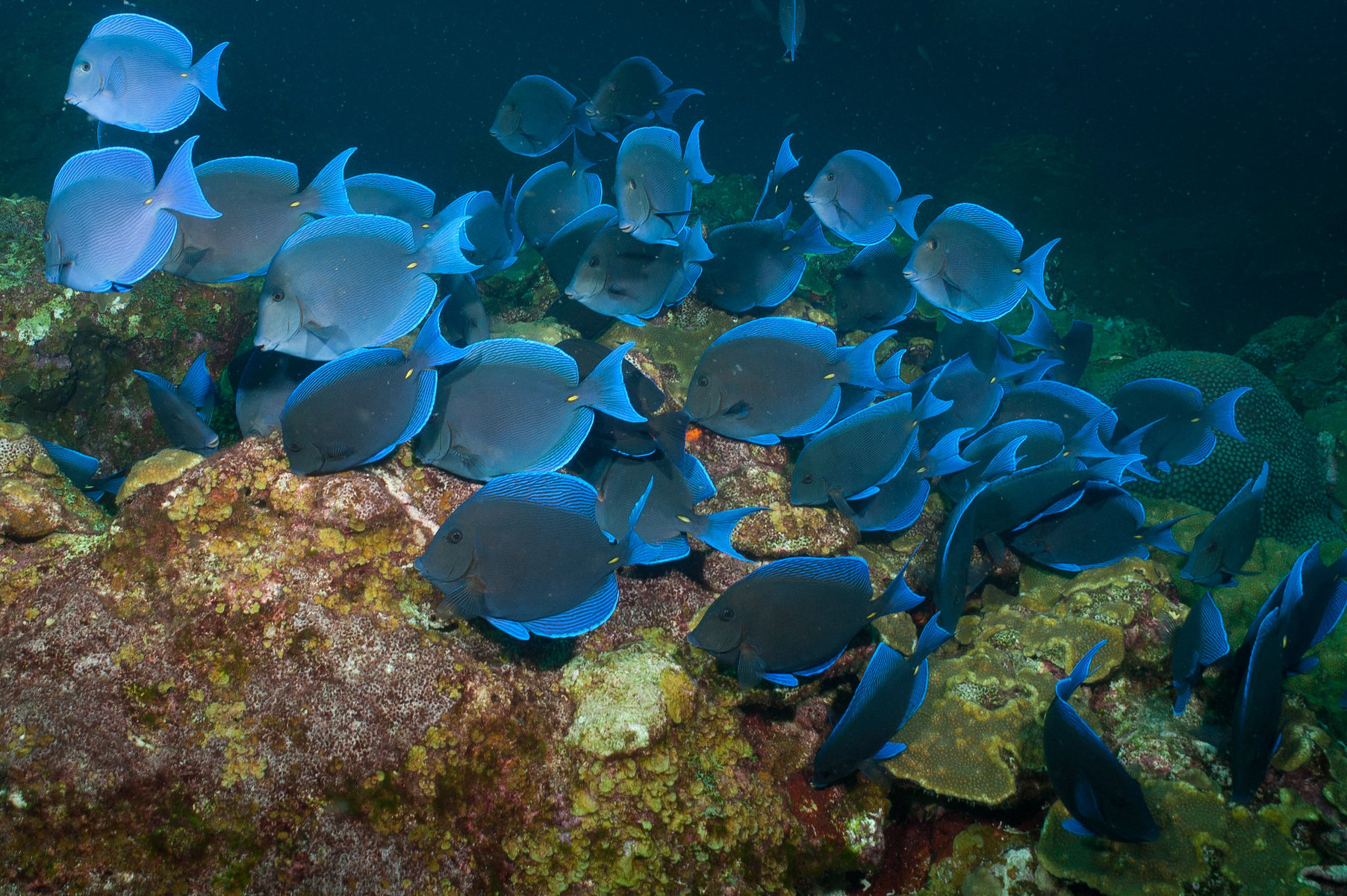 A school of blue tang swim about the reef in Flower Garden Banks National Marine Sanctuary. Credit: G. P. Schmahl / Flower Garden Banks NMS
A school of blue tang swim about the reef in Flower Garden Banks National Marine Sanctuary. Credit: G. P. Schmahl / Flower Garden Banks NMS
When people ask her what they can do to help, the mother of three and grandmother of four tells them to focus on what they love. “You know, we’re causing the problems,” she says. “So we can also cause solutions. You can make change right now, at home. You can make change every day with what you eat, what you wear, with how you vote, with what you plant in your garden if you have access to a yard, with the organizations you join. Would you like to be part of the generation that safeguards our species, safeguards the future of life on earth?”
And of course, anybody can nominate a Hope Spot.
Crushed by negative news?
Sign up for the Reasons to be Cheerful newsletter.
[contact-form-7]
“We should look at this as the best time ever to do something,” Earle insists. “It’s just getting to the point where people realize the urgency. We have to change if we are to survive. It has taken us a very short period of time to begin to seriously unravel the stability of the systems that we absolutely require for our existence. Now imagine if we didn’t know that. That would be a real problem. But we do know now and we know what to do.”
Earle is relentlessly positive when it comes to the future, and the opportunity we have right now to shape it. “That is a reason to be cheerful,” she says. “We know more than ever before at any time in history, and here’s the opportunity to really size up. Where do we want to go? Because we do have choices.”
The post The Legendary Ocean Explorer Protecting ‘Hope Spots’ Around the World appeared first on Reasons to be Cheerful.
Q and A with David Stainforth on Predicting Our Climate Future: What We Know, What We Don’t Know, and What We Can’t Know
We speak to David Stainforth about his new book, Predicting Our Climate Future: What We Know, What We Don’t Know, and What We Can’t Know, which argues for a re-evaluation of how we go about the study of climate change in the physical sciences, the social sciences, economics and policy.
You can watch a public LSE event with David Stainforth to launch the book from October 2023 on YouTube here.
Predicting Our Climate Future: What We Know, What We Don’t Know, and What We Can’t Know. David Stainforth. Oxford University Press. 2023.
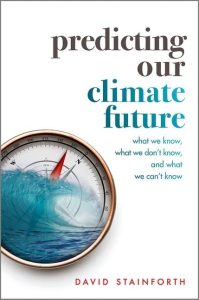 Q: Where did the idea for the book come from and what were you setting out to do in writing it?
Q: Where did the idea for the book come from and what were you setting out to do in writing it?
Between 2000 and 2015, I became aware that my perspective on what we should be trying to do in climate change science wasn’t at all reflected in the practice of research in research institutions. It seemed to me important to write something that would engage people with all the fascinating challenges that exist in understanding the problems of climate change. Doing so, I hoped, would help make clear the separation between what we know and what we don’t know.
Many big, fundamental, questions – philosophical, mathematical, physical, and economic questions – about climate change tend not to be examined, probably because of the urgency for society to act.
If I was a sixth-former now, I would certainly see climate change as an important issue for society, but I’m not sure I would be passionate about trying to understand it. That’s because it appears that we already understand it, although in fact we don’t. Many big, fundamental, questions – philosophical, mathematical, physical, and economic questions – about climate change tend not to be examined, probably because of the urgency for society to act. My book addresses these questions. I would love for my book to stimulate high-school students and undergraduates across diverse disciplines to say, actually, there’s something really fascinating to get my teeth into here; something that humanity hasn’t yet understood.
Of course, none of this undermines the importance and urgency of acting on climate change, but acting and understanding need to go hand in hand.
Q: What are the limitations of scientists’ understanding of the climate system? How do these affect our ability to predict how the climate will change?
The central issue is complexity and there are two aspects of complexity that create a barrier to predicting what the climate future will look like.
The climate system is made up of many components – the atmosphere, the oceans, land ecosystems, ocean ecosystems, biogeochemical systems, the cryosphere etc. Many of these can be broken down further into subsystems, and all of this is before you get into the social aspects. The first aspect of complexity is simply how these many disparate components interact.
Certain types of system, like the climate system, have real barriers to predictability because what happens in the future can be very sensitive to the state of the system today. This is what’s meant by the “butterfly effect”.
The second aspect of complexity is more mathematical. Certain types of system, like the climate system, have real barriers to predictability because what happens in the future can be very sensitive to the state of the system today. This is what’s meant by the “butterfly effect”. At the same time, the relationship between our models and reality is unclear: how close does a model have to be to reality for it to be able to tell us something about how reality will behave? That’s a difficult question to answer; it might be that our models could represent reality very closely, but still provide unreliable predictions. This is something that Erica Thompson has named the “hawkmoth effect”; it’s something we haven’t really begun to study.
These types of complexity affect how we should be designing our climate models and what sort of experiments we should run with them.
Q: What do Global Climate Models (GCMs) do and what are their limitations?
Global Climate Models break down the atmosphere and ocean into grid points and at each grid point they solve the equations of motion to tell us how things change over time. This is what’s known as a reductionist approach to modelling, and it allows us to work out what the state of the atmosphere or ocean system might be at some point in the future. Solving the equations on a computer can typically only tell us how things will change over about 10 minutes, so you’ve got to repeat the process millions of times to get information for 100 years ahead.
There are lots of elements of the climate system that can’t be modelled [in a reductionist] way, either because we don’t know what the fundamental equations are or because the processes take place on scales that are far too small to include in the models.
But there are lots of elements of the climate system that can’t be modelled that way, either because we don’t know what the fundamental equations are or because the processes take place on scales that are far too small to include in the models. Examples include how ecosystems absorb and release carbon dioxide and how clouds and rainfall form. For these components there are various different ways to approximate the processes at play, but it’s not easy to know how reliable these approximations are. And because all aspects of the climate system affect all the other aspects of the climate system, this means that the model predictions can’t simply be taken as predictions of reality.
Q: Why do we rely so heavily on GCMs for climate prediction and policy development today? Is there a danger in relying too heavily on these models?
When we study climate change, we don’t have multiple climates to examine. The time scales and the system are defined: it’s our real-world climate system that we’re interested in, and how it will change through the 21st century. We are doing an experiment on the real climate system through humanity’s emissions of greenhouse gases, but we’ll only ever get one result, and that will come too late to be of much use to us. The models enable us to study what we can’t study in reality – for instance, multiple possible scenarios of future greenhouse gas emissions. But we need to always remember that we’re studying a model, not reality. The power, the detail and the ubiquity of the models encourages us to avoid asking the big questions about how the model predictions relate to reality – whether what they’re telling us is actually what we think will happen.
When we study climate change, we don’t have multiple climates to examine. The time scales and the system are defined: it’s our real-world climate system that we’re interested in, and how it will change through the 21st century.
Research on climate, particularly with models, has grown out of work on weather forecasting. The reliability of weather forecasts over the last 20 to 30 years has massively improved, principally because of these models. But in the shift from weather forecasting to climate forecasting, we are dealing with a fundamentally different problem. In weather forecasting, we don’t need to get the whole of the climate system right: it’s mainly just about simulating the atmosphere. Furthermore, we repeat the weather forecasting process three or four times a day, so we can compare the model’s predictions against what happens in reality. That means we can test whether our models are doing a good job in a way that is impossible for climate predictions
With climate, you need to bring in many other elements of the climate system, including oceans and ecosystems, and we don’t have the same possibility to verify the results. This puts us in a very different domain, but the problem is that it doesn’t feel that way. It feels as though weather forecasting and climate predictions are very similar because they use similar, related models. This represents a barrier to using the models effectively to help us provide reliable information about future climate.
Q: Why do you argue that greater diversity of climate models rather than greater “realism” of climate models should be the goal for better climate prediction?
Aiming for realism tends to take us to higher and higher resolution models. These models represent atmospheric behaviour better and they look more realistic, but this lulls us into a false sense of security. Despite the “realistic” appearance of these models, we can’t tell if they are accurate because we’ve never observed the planet in the warmed state that we’re interested in.
High-resolution models also take a lot of computing time to run, and consequently they remove the possibility of exploring other uncertainties such as how we represent the carbon cycle or biogeochemical processes. There’s a substantial risk therefore that we adapt society to be resilient to the changes in our models, when what might actually happen could be very different.
If […] we were to address different ways of building our models and of accounting for the many uncertainties, this would give us a diversity of predictions.
If instead we were to address different ways of building our models and of accounting for the many uncertainties, this would give us a diversity of predictions. Having a better understanding of the wide range of different changes that could plausibly happen would enable us to be better prepared and is, in my view, crucial to building a robust response to climate change.
Q: How does the separation between disciplines, which approach the issue in very different ways, hamper our understanding of, and ability to act on, climate change?
Assessments of the economics of climate change and of the consequences for our societies, for our wealth, for our welfare etc., often don’t take sufficient account of the uncertainties in the physical science. There is a real need for economists to understand the processes of the physical sciences better.
Assessments of the economics of climate change and of the consequences for our societies, for our wealth, for our welfare etc., often don’t take sufficient account of the uncertainties in the physical science
However, if we want the physical climate sciences to help us prepare effectively for our future world, then we need to ask, what are the questions that are being addressed by agricultural scientists, by city planners, by economists and by policy makers. Only when we are clear what kind of information is being sought, can we direct the physical sciences in a useful way. At the moment, the physical scientists set the questions and pass on the resulting information to social scientists rather than focusing their experiments and models on what social scientists and society need to know most.
We are stuck in a traditional approach which is not serving society well.
Q: How could we enable greater interdisciplinary research around climate change?
We require big changes in how we do climate change research. We need to be a lot clearer about what we’re trying to address and how the connections between disciplines work. I think that means high-level change to how we study the problem.
Historically climate change research has been very siloed, as academia generally is. There is a need for the research funders to grasp the nettle of wholesale change and for universities and research institutes to come together and create career paths that enable people to research across disciplinary boundaries.
There is a need for the research funders to grasp the nettle of wholesale change and for universities and research institutes to come together and create career paths that enable people to research across disciplinary boundaries.
I don’t think the importance of multidisciplinarity for understanding fundamental features of the threats posed by climate change has been fully recognised. There are still many funding calls that are essentially answer-driven. It’s a “tell us what will happen to this bit of the system” approach, but that’s not what climate change is. You can’t tell what’s going to happen to one aspect without connecting it with everything else. It’s a big, complex problem and needs to be addressed as such.
As a starting point we need funding – 10, 20 million pounds – for a centre that can bring truly diverse researchers together from philosophy to physics to economics, and give them the stability of five to 10 years to work on these problems together. That’s the starting place for better information about our climate future. It’s also the starting place for training a cohort of experts who have both the breadth and depth of knowledge to be able to build climate resilient societies and communicate what climate change risks actually look like.
Note: This interview gives the views of the author, and not the position of the LSE Review of Books blog, or of the London School of Economics and Political Science. The interview was conducted by Anna D’Alton, Managing Editor of LSE Review of Books.
Main Image: Arctic sea ice by Kathryn Hansen / NASA on Flickr.
The EU Just Banned Microplastics. How Are Companies Replacing Them?
A blue whale can ingest about 10 million pieces of microplastics per day. This alarming fact, drawn from a recent study, underlines what has become increasingly clear: Microplastics — solid plastic particles up to five millimeters in size that are not biodegradable — are pretty much everywhere.
They have been detected in over 1,500 different marine animal species. They also find their way into our bodies via the water cycle and the food chain. In fact, the average person consumes up to five grams of microplastics per week. That’s as much as a credit card. The consequences for our health and the environment remain to be seen.
In a move to stave off further damage, the European Union has now banned intentionally added microplastics. This applies to plastic glitter or polyethylene particles used as abrasives in scrubs, shower gel and toothpaste (these have been banned in the US since the 2015 Microbead-Free Waters Act). Under the terms of the ban, some products, such as plastic glitter found in creams or eye shadow, have been granted a transitional period to give manufacturers a chance to develop new designs.
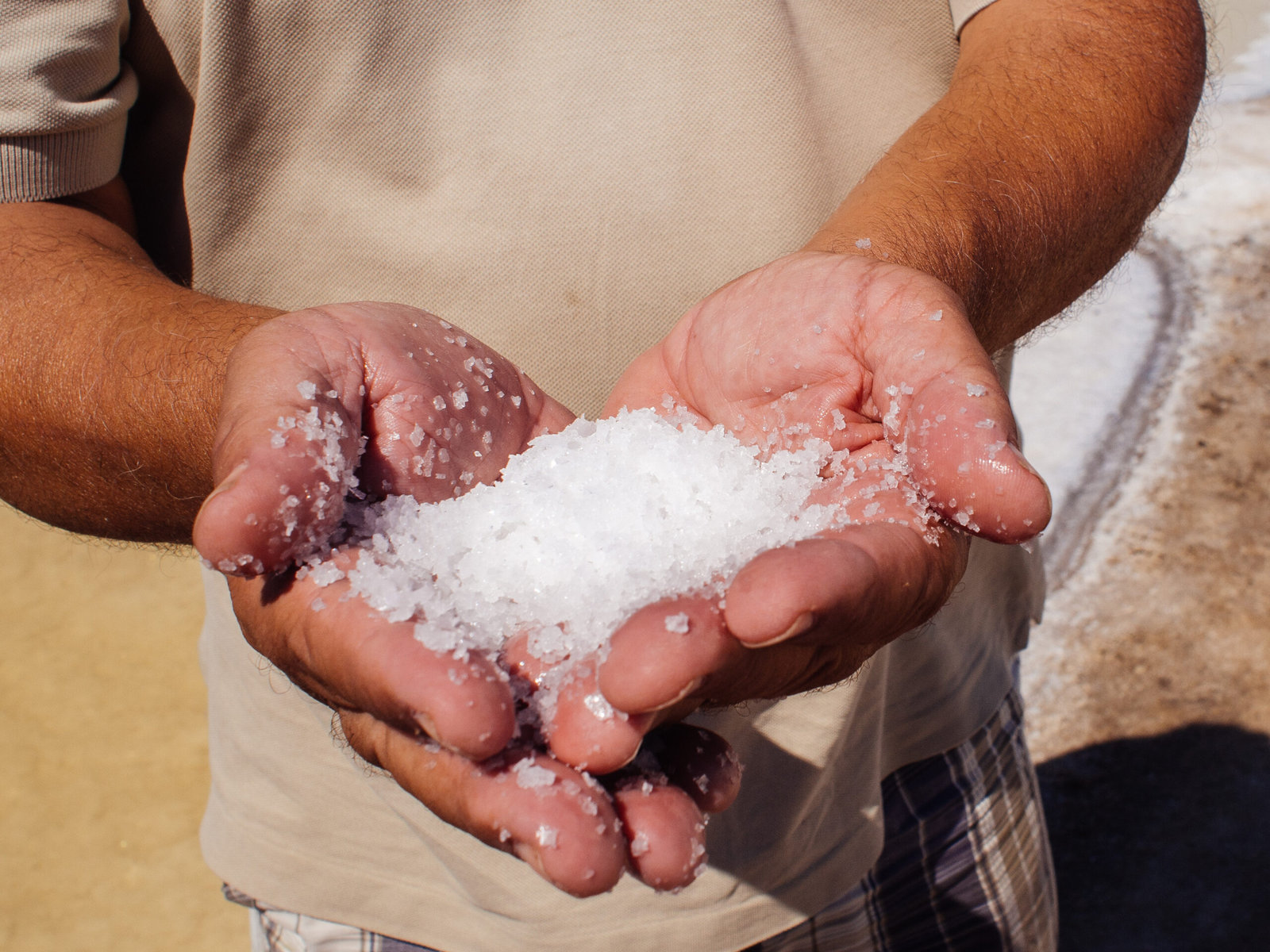 In some of its products, LUSH uses salt in place of microplastics. Courtesy of LUSH
In some of its products, LUSH uses salt in place of microplastics. Courtesy of LUSH
But some manufacturers are years ahead of the game when it comes to pioneering the move away from microbeads. LUSH and The Body Shop are among the companies that have long been offering natural alternatives, using ground nuts, bamboo, sea salt and sugar. The really big players, such as Beiersdorf AG, have also been working on solutions for several years.
The Hamburg-based consumer goods group has not used microbeads for exfoliation purposes since 2015. Instead, it has used, for example, cellulose particles or shredded apricot kernels. Since the end of 2019, all Beiersdorf wash-off products have been free of microplastics. In addition, the company uses almost no microplastics in creams and other leave-on cosmetics for its two major body care brands, Nivea and Eucerin. “Our ambition is to use only biodegradable polymers in our European cosmetic product formulas by the end of 2025,” explains a company spokesperson. However, these polymers can take many months to degrade. And they may prevent the development of more sustainable solutions.
 LUSH’s Bjork sugar cleanser uses sugar in place of microplastics. Courtesy of LUSH
LUSH’s Bjork sugar cleanser uses sugar in place of microplastics. Courtesy of LUSH
There have also been alternatives for artificial turf pitches — which use tons of microplastics as loose fill — for some years now. There are more than 9,500 such sports pitches in Germany alone. “These particles can quickly be carried into the environment by wind and weather or sports shoes,” says Jürgen Bertling from the German Fraunhofer Institute for Environmental, Safety and Energy Technology (Umsicht). According to the European Chemicals Agency, artificial turfs release up to 16,000 tons of microplastics into the environment in the EU every year.
Crushed by negative news?
Sign up for the Reasons to be Cheerful newsletter.
[contact-form-7]
But a few years before the EU ban, Germany stopped providing public funding for artificial turf pitches with granules containing a high proportion of microplastic. As a result, the country already has hundreds of pitches that are filled with cork and sand instead of microplastics, according to the International Association for Sports and Leisure Facilities. Ground olive stones or corn-based fillings have also been used on some pitches.
One of the most sustainable facilities in Germany was completed a year ago by the Lower Saxony club VfL Sittensen. Their artificial grass is made from plant-based polyethylene. The granules are produced mostly from hemp and chalk. Compared to other artificial turf pitches, this pitch only needs a fifth of the amount of granulate. In addition, a filter system for the rainwater run-off prevents the remaining microplastic and fiber residues from entering the environment. “We receive many inquiries from other clubs and local authorities who want to follow this example,” says Egbert Haneke, the association’s chairman.
 Hundreds of artificial turf pitches in Germany are filled with cork and sand instead of microplastics. Courtesy of VfL Sittensen
Hundreds of artificial turf pitches in Germany are filled with cork and sand instead of microplastics. Courtesy of VfL Sittensen
But there are other, much bigger sources of microplastics in Germany. According to a study by the Fraunhofer Institute Umsicht, artificial turf pitches are only the fifth-largest source. And though cosmetics are the one that the public tends to hear the most about, they are a relatively insignificant source compared to the heavy-hitters, like waste disposal, building materials, road wear and fibers released through textile washing.
Germans produce an estimated four kilograms of microplastics per capita in the environment every year. At around 1.2 kilograms per capita, tire abrasion is the most important contributor. Tiny particles are released through the wear and tear of tires, and counterintuitively, the move toward electric vehicles will actually exacerbate this problem. Electric cars are significantly heavier than combustion engines due to their batteries. A toxic compound released by tire abrasion has even been linked to the deaths of coho salmon on the US West Coast.


Become a sustaining member today!
Join the Reasons to be Cheerful community by supporting our nonprofit publication and giving what you can.
A startup in the UK has found a possible solution: The Tyre Collective has developed a suction device that can be fitted directly behind the tires on the underbody of a car.
The patent-pending technology uses electrostatics and airflow to attract tire particles. Together with the London logistics company Zhero, The Tyre Collective tested prototypes on London’s streets for three months. According to the startup, over half of the particles that the device captured were below 0.01 millimeters in size. Particles of this size are considered “the most harmful to human health and the environment,” according to The Tyre Collective. Working with designers, the start-up has also developed various products made from tire particles and recycled plastic using 3D printers. A vase, speaker, lamp and acoustic panel were exhibited at the London Design Festival at Material Matters in September 2023.
 A prototype of The Tyre Collective’s suction device. Courtesy of The Tyre Collective
A prototype of The Tyre Collective’s suction device. Courtesy of The Tyre Collective
But by far, the greatest potential for reducing microplastics lies in not producing them in the first place: for example, by driving less or slower so fewer particles are released via tire wear, or by changing the composition of the material of tires or the design of the tread. And microplastic emissions from textile washing could be reduced by using different materials and designs.
That’s why, though the ban is an important step, experts like Jürgen Bertling are hanging their hopes on the EU’s ecodesign guidelines, which will be developed for the various product groups over the coming years. Something to look forward to, for humans and blue whales alike.
The post The EU Just Banned Microplastics. How Are Companies Replacing Them? appeared first on Reasons to be Cheerful.